|
President’s Word
From incremental to disruptive innovation: the packaging industry
heats up!
Luciana Pellegrino
President of WPO
Greetings!
We're back with another exciting update on the global
packaging industry. Since our last edition, there's been a flurry of activity!
Our dynamic industry is constantly evolving, and the months of April, May, and
June pushed boundaries and reshaped possibilities once again.
Innovation fueled by collaboration
Packaging innovation thrives at the intersection of technology,
sustainability, market demands, and passionate professionals. Recent months
provided opportunities for global collaboration and exploring future trends. And
WPO was all around promoting the connection of the global packaging community. I had a busy schedule as well, but not alone, luckily counting
with Board Members from all around the globe on the ground!
CiclePack Show in Chile: In April it was my honor to represent
WPO at CiclePack Show in Chile, organized by our packaging member, CENEM. The
show gathered Latin American exhibitors and visitors to explore sustainable
packaging solutions, besides some very interesting panels, and it is rewarding
to acknowledge the maturity of the show and its positive impact to foster
packaging advancement and business opportunities in the region.

Propak Mena, Egypt: Invited by Informa Markets, in May, it
was a remarkable experience to join a bold delegation of WPO Board Members from
the Arab and African regions, getting to know new members in person, and reconnecting
with long time colleagues, counting as well with WPO’s national member, the
Chamber of Printing and Packaging Industries. WPO’s training program took place
alongside the show while Board Members participated in various panels,
including a Round Table on Sustainable Food Systems organized and chaired by
LibanPack and UNIDO, supported by Informa Markets and WPO.
Last but not least, since we are all driven by packaging
innovation, it was an immense satisfaction to take part of the gala ceremony of
the Arab StarPack Awards.

Drupa Show: In the meantime, WPO Board Members attended the
Drupa show, experiencing groundbreaking innovations driven by AI. These
advancements promise to significantly enhance accuracy and efficiency in
printing and packaging processes, even offering micro-mass personalization
possibilities.
Expo Pack Mexico: June started with Expo Pack Mexico,
organized by PMMI, and it was an immense pleasure to visit the show on behalf
of WPO, and to attend a panel on Women in Packaging. We explored how companies
can support initiatives to empower women in reaching leadership positions, from
strategic career roadmaps and social culture, building to foster childcare
support infrastructure.
During this visit, I had the honor of presenting the awards
at the Envase Estelar ceremony, organized by WPO's member AMEE (Mexico's Packaging
Association). Moments like this strengthen our industries and empower their
professionals.

Propak Asia and WorldStar Award Ceremony: a global celebration
of packaging! Finally, these dynamic months culminated with Propak Asia in
Bangkok, and WPO had a bold participation throughout the event counting with 40
Board Members, from 29 countries. WPO's participation was significant at
Opening Ceremony, a Round Table with the Asian packaging bodies, innovation
stage and zone with packaging samples, conferences and panels, and we launched
the Networking Cocktail for WPO Corporate Partners.
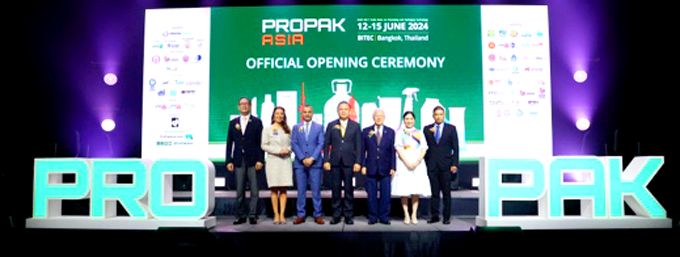
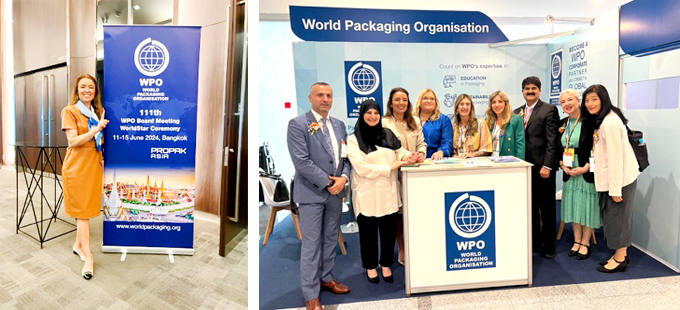
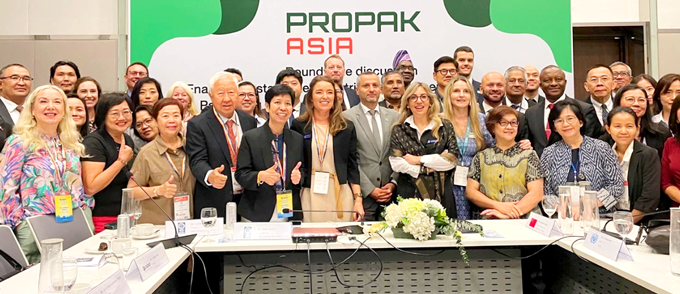
This event had as well a special meaning for me as I chaired
my first WPO Board Meeting, as President, alongside with WPO’s Vice Presidents
and the first Executive Meeting with the new Ambassadors.
To close, an unforgettable night handling the awards at the
unique WorldStar Awards Ceremony, in a event counting with more than
300 participants from around the world and WPO Board Members celebrating
packaging innovation on a global level.


And this is just the beginning! Enjoy this insightful
edition of WPO News.
 [email protected] [email protected]
 WPO – World Packaging Organization
WPO – World Packaging Organization
 www.linkedin.com/in/lucianapellegrino www.linkedin.com/in/lucianapellegrino
 @WorldPackOrg1
@WorldPackOrg1
 worldpackagingorg
worldpackagingorg
 World Packaging Organization
World Packaging Organization
Message from General Secretary
Recap of the WPO Meetings at ProPak Asia
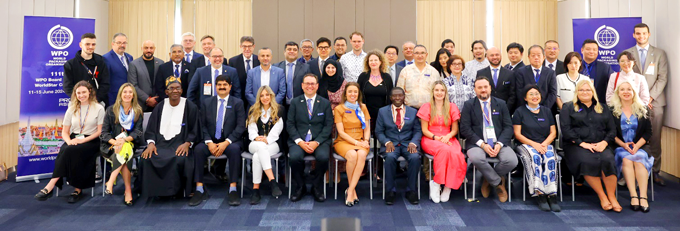
Dear members, once again it's that time of
year when we come home with warm hearts after another magnificent WPO Board
Meeting. This time, we had the opportunity to meet in the stunning city of
Bangkok in Thailand and hold our meetings and the WorldStar Awards Ceremony in
parallel with ProPak Asia.
A series of strategic meetings were held,
as for our Executive Meeting, the Education, Marketing and Sustainability &
Save Food Working Groups; the Roundtable discussion entitled "Enabling
Sustainable Industrial Development of the Food Packaging Industry to Reduce
Food Loss and Waste" and finally the grandiose WPO Board Meeting. We also
used this opportunity to welcome our corporate partners to an exclusive
networking event.
At our meetings, around 40 participants
were brought together to discuss and plan for the future. The discussions were
filled with wisdom, foresight, and a shared commitment to making positive
changes. We are incredibly grateful for the thoughtful insights and visionary
ideas that were shared during this important session.
Hosting the prestigious Worldstar Global
Packaging Awards ceremony was a privilege. It was a breathtaking celebration of
creativity, excellence, and innovation in the packaging industry. We want to
extend our heartfelt congratulations to all the winners for their outstanding
achievements. Your vision and commitment to pushing boundaries have set new
standards of brilliance in our industry.
There was also the opportunity to discover
the latest packaging innovations and trends presented at ProPak Asia. The fair
presented a wide range of innovations, from sustainable packaging solutions to
cutting-edge automation technologies, which WPO members were able to learn
about.
We had some leisure time with good old
friends where we had the opportunity to taste some good Japanese food and get
to know a little better the culture of this amazing country.
Now, as we say goodbye to this incredible
week in Bangkok, we want to remind you of the exciting opportunities that lie
ahead. We are thrilled to announce that our next meeting will take place from
November 18th to 22th in the beautiful city of Buenos Aires, Argentina. Please
keep an eye on your e-mails, you will soon receive information about our next
meeting.
Until we meet again, let's carry the spirit
of collaboration and innovation in our hearts, and let's continue to make a
positive impact on the world through packaging.
And now, enjoy some of WPO moments at ProPak
Asia!
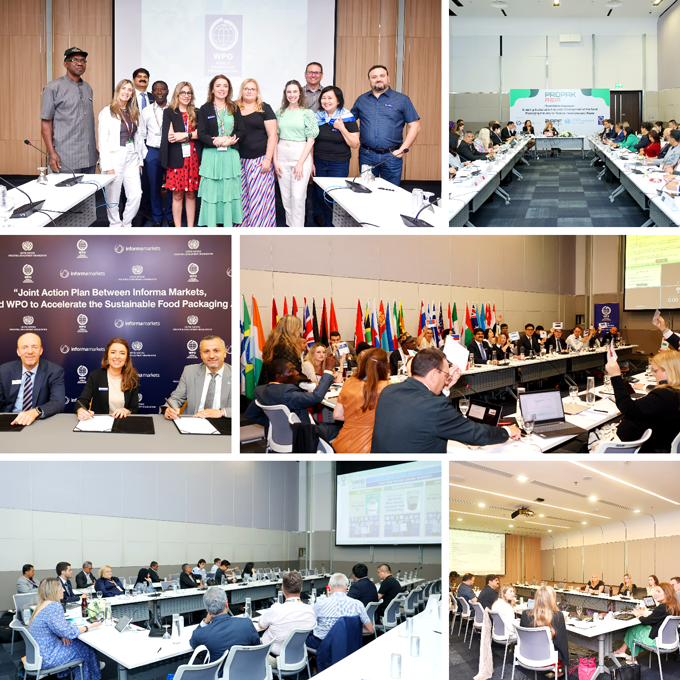
Warmest regards,
Nathália Antoniazzi
WPO Secretariat
[email protected]
Johannes Bergmair
WPO General Secretary
[email protected]
From the Editor
What we know about the Global Plastics Agreement: past discussions
and future actions.
By Liliam Benzi*
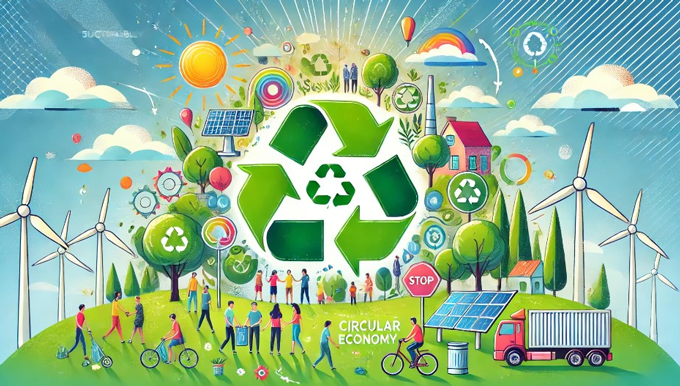
The Global Plastics Agreement is a hot topic internationally
and it is important to be updated on the past resolutions and the upcoming
steps. In April, the fourth round of discussions took place in Canada, and the
debate evolved to address the entire lifecycle of plastics. Despite being an
agreement still immature in some aspects, the fact is that the discussions are
advancing.
To provide some context, this Agreement, formally known as
the Global Plastics Treaty, is an international initiative promoted by the
United Nations (UN) aimed at creating a legally binding treaty involving all UN
member countries to reduce the production and consumption of plastics, promote
a circular economy, and improve waste management.
Interestingly, the fourth meeting faced a significant
challenge: waste management, rather than simply condemning plastic. To
understand and openly discuss what this challenge means in practice and its
impacts, some specialists recently shared important insights about the last
meeting, in Canada, and what to expect from the next meeting scheduled for
November 25 to December 1, 2024, in Busan, Republic of Korea.
They believe that the next round of negotiations will be
crucial for finalizing the Agreement's text based on a lifecycle approach, from
production to disposal. The experts also noted that previous negotiations,
including the fourth session in Ottawa, were important steps for advancing the
text of the instrument and establishing the necessary intersessional work to
prepare for INC-5.
It is worth noting that urban solid waste disposal is a
common problem in many countries and, therefore, the Agreement's main focus
should really be on waste management, involving all stakeholders. In other
words, the Agreement is an opportunity to leverage plastic disposal,
reintegrating it into the chain as a valuable raw material.
Several countries, including Brazil, strongly supports the
existence of the Global Plastics Agreement and advocates for plastic waste to
become a raw material. For this to happen, the chain must be economically
viable, which depends on consistent demand and extended producer responsibility
(EPR).
It is also important to understand that mechanical
recycling, although crucial, has its limitations. Therefore, investment in
chemical recycling is necessary, allowing for a longer cycle of plastic
materials, transforming them into molecules that can be reused as if they were virgin
materials, even for food contact. Thus, the development of new technologies by
the chemical industry is essential.
Inclusion of waste pickers, a fundamental pillar.
Another important voice in this debate are the waste
pickers. They are seen as key players in the recovery of plastic waste and
should be adequately remunerated for their work. Everyone agrees: "The
fair inclusion of waste pickers is essential. They are part of the value chain
and should be compensated for the environmental services they provide."
Equally important is designing plastic products based on
science, aiming to ensure minimal environmental impact without losing
functionality. The transformation of design is also crucial for the Agreement
to rethink the entire plastic production chain.
The industry, in turn, plays a vital role in providing
knowledge and developing new technologies. The participation of all actors –
government, industry, civil society, waste pickers/cooperatives – is crucial
for the success of the Agreement, which has the potential to transform waste
management in the world, promoting a circular economy that minimizes resource
waste and maximizes efficiency and sustainability.
As discussed in Canada, the main points of the Agreement
are:
- Improvement of waste management, including the
collection, recycling, and proper treatment of plastics to prevent them from
becoming "lost" in various ecosystems.
- Innovation and Circular Economy, promoting practices that
involve reuse, recycling, and revaluation of plastic products, and including
the development of new technologies and more sustainable materials.
- EPR (Extended Producer Responsibility) to ensure that
producers take responsibility for the waste generated by their products
throughout their entire lifecycle.
- Engagement and Education through
incentives for public awareness and education about the impacts of waste on the
environment, as well as the sustainable practices that can be adopted by
consumers.
The time is ripe for significant advances towards a more
circular economy. It is hoped that the next round of negotiations, INC5, will
result in a treaty for plastics and waste in general. It is expected that after
the next negotiations, the Agreement should be transformed into specific
decrees and regulations that will affect the entire value chain positively.
Remembering that the need for a Global Agreement arose from
the need to harmonize global efforts toward waste reduction, providing a common
legal framework that can be adapted to the realities of each country, but that
maintains a level of commitment and coordinated action at an international
level.
Its implementation will not be easy and will face various
challenges. However, the treaty will also offer significant opportunities for
innovation, development of new sustainable technologies, and the creation of
new jobs and business opportunities. We can conclude that the Global Plastics
Agreement is an important collaborative effort to mitigate environmental
impacts and promote a more sustainable future.

*Liliam Benzi is the Editor of WPO News, WPO Press &
Communication Liaison Officer and runs its own Communication & Strategy
company for the packaging industry, LDB Comunicação Empresarial ([email protected]). She was recognized ‘Packaging Professional
of the Year’ in Brazil.
 [email protected] [email protected]
 (+ 55 11) 99989-1597 (+ 55 11) 99989-1597
 liliambenzi liliambenzi
 liliam-benzi-870b771a liliam-benzi-870b771a
 Liliam Benzi Liliam Benzi
Agenda
WPO at FACHPACK 2024
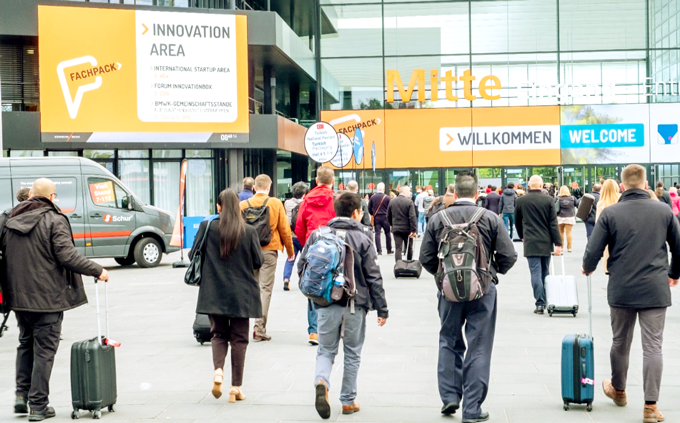
WPO is planning its participation at FACHPACK (www.fachpack.de) that will take place in the Exhibition Centre
Nuremberg (Germany), from 24 to 26 September. The show provides a compact and comprehensive
insight into all relevant issues in the packaging industry.
This year the big theme will be “Transition in Packaging”.
In 11 exhibition halls, around 1,400 exhibitors will showcase innovative
packaging solutions for industrial and consumer goods from a wide range of
segments. The most pressing and simultaneously most interesting topic for the
industry is the EU Packaging and Packaging Waste Directive (PPWR) that was
adopted at the end of April.
Here too, FACHPACK will provide answers to questions about
issues like recyclability, reusability and the use of recycled materials.
Reason enough to start planning your trade fair visit now so that you can be
part of the action at the end of September.
The WPO encourages everyone to take part in this event.
Registrations can be made via the link https://www.fachpack.de/en/visit with the
code A541451.
For more information about WPO participation, contact the
Secretariat, Nathália Antoniazzi by e-mail [email protected].
Around the World
Significant activities in Latvia
#1 Packaging industry conference
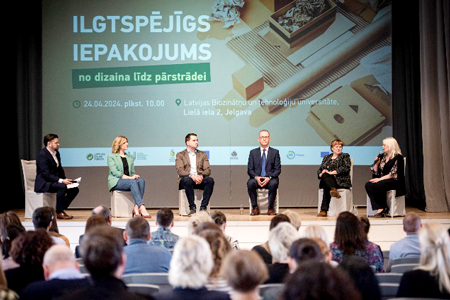 WPO member, the Packaging Association of Latvia (LIA – www.packaging.lv) was one of the co-organizers of the annual
packaging industry conference "Sustainable Packaging: from design to
recycling" together with Latvijas Zalais punkts (The Green Dot of Latvia /
LZP) and the Latvia University of Life Sciences and Technologies (LBTU). WPO member, the Packaging Association of Latvia (LIA – www.packaging.lv) was one of the co-organizers of the annual
packaging industry conference "Sustainable Packaging: from design to
recycling" together with Latvijas Zalais punkts (The Green Dot of Latvia /
LZP) and the Latvia University of Life Sciences and Technologies (LBTU).
The event gathered more than 150 packaging industry
specialists and several industry experts. One of the speakers was Sandra
Muižniece-Brasava, the newly elected Chairperson of the LIA Board and head of
the Technology and Knowledge Transfer Department at LBTU, who introduced the
findings of research analyzing more than 3,000 plastic packaging items
available on the shelves in Latvia regarding the problems related to packaging
efficiency and recyclability.
Other topics discussed in the conference and in the panel
discussion included promoting packaging sustainability through legislative and
regulatory updates, sustainability in the context of “EIT Food”, 100 types of
plastics – how many recycling options, new polymer materials testing laboratory
accelerating the transition to recyclable packaging.
#2 TV interview
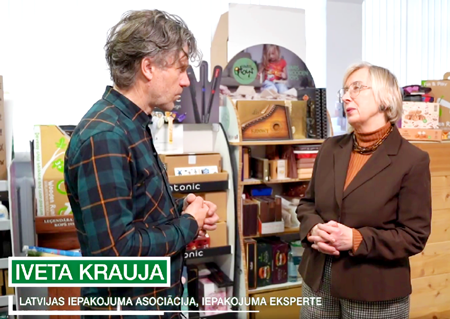 Iveta Krauja, former longstanding Chairperson of the the
Packaging Association of Latvia (LIA – www.packaging.lv)
Board, a WPO member, gave an interview to the local ‘Greenwashing’ show. She
advised on the need of packaging and its impact on the environment, and the
possibilities of choosing more environmentally friendly packaging. Iveta Krauja, former longstanding Chairperson of the the
Packaging Association of Latvia (LIA – www.packaging.lv)
Board, a WPO member, gave an interview to the local ‘Greenwashing’ show. She
advised on the need of packaging and its impact on the environment, and the
possibilities of choosing more environmentally friendly packaging.
#3 Roundtable
The Packaging Association of Latvia (LIA – www.packaging.lv), a WPO member, took part in the roundtable
discussion with the Ministry of Agriculture and the Latvian Federation of Food
Companies on "Improving ecosystem synergies in the context of sustainable
packaging". The discussion brought Ministry representatives, industry
experts and food chain participants to discuss the challenges and possible
solutions in developing and promoting sustainable packaging in Latvia.
CAVENVASE renews its authorities for the 2024-2026 period
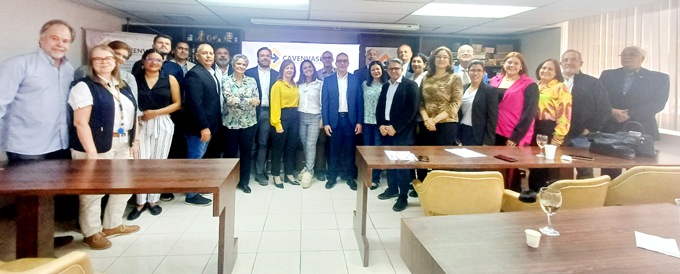
On May 21st, the Venezuelan Packaging Association (CAVENVASE
– www.cavenvase.org), a WPO member, celebrated its Ordinary
General Assembly in which the Board of Directors presented the results for the
year 2023, the financial statements of the organization and the elections of
authorities for 2024-2026.
Two important achievements of the Board of Directors in 2023
were highligthed: the historic milestone of the internationalization, being
accepted as WPO full member, and completing the first Boot Camp in Venezuela
about design, development and technology in packaging.
This was an advanced 120 hours course, completed in 16
weeks, with the mission to transmit theoretical and practical knowledge to the
participants. After the Camp, professionals had the skills required in
packaging design, development and technology, in order to create a competitive
and sustainable packaging project.
The newly elected Board of Directors of CAVENVASE, headed by
its first female President, Miren Urresti, confirmed its commitment with the
Venezuelan packaging industry, working on its defense and promotion, reporting
on industry advances, and training packaging specialists. CAVENVASE will
continue working for its affiliated companies, for the packaging community and,
above all, for the development of Venezuela.
Legislation in action in Ukraine
On April 17, 2024, during the Ukrainian exhibition Pack Fair
2024, WPO member, the Club Packagers of Ukraine (www.upakjour.com.ua or www.packinfo.com.ua)
held the panel ‘Legislative Acts in Action’, which was opened by Veronika
Khalaydzhi, President of the Club Packagers. She noted the importance of compliance
with laws, regulations and standards related to food packaging, as one of the
most important factors to ensure access of Ukrainian products to European
markets.

Gennady Kuznetsov (League of Food Producers) spoke about the
adoption of the law ‘On materials and objects intended for contact with food
products’ as a step towards European Integration; Volodymyr Slabiy (Ukrainian
Packaging and Environmental Coalition) presented the law project ‘On packaging
and packaging waste" and Svitlana Berzina (Living Planet) spoke about
packaging ecolabelling.
Seminar, in Greece, discussed the new regulation on
packaging and packaging waste

Wpo member in Greece, AGMPM (www.pac.gr) and the
European Organization EUROPEN, organized on May the first introductory seminar
on the final text of the new European regulation on packaging and packaging
waste (PPWR).
Marzia Scopelliti, Public Affairs Manager of Europen,
analyzed the critical chapters of the new regulation: criteria for
recyclability of all types of packaging and the possibility of circulating
packaged goods on the European market, recycled content of plastic packaging
(PCR), new mandatory labeling of packaging in transit, reduction of packaging
through horizontal bans of certain structures, re-use requirements, etc.
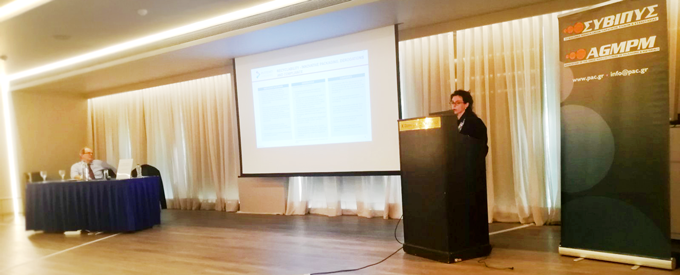
During the Q&A session, a significant part of the
discussion was dedicated to the availability of PCR for plastic primary
packaging of food and beverages, the approval of chemical recycling and the use
of bio-based polymers, and the tigth time frame between the publication of the
guidelines and the implementation milestones (2030).
AGMPM works and coordinates its educational actions on a
weekly basis with the Europen Organization aiming to inform and prepare Greek
companies in view of the implementation of a large number of new legislations
in the European market.
For more information about the presentation of the
representative of the Europen organization send an e-mail to [email protected].
AIP activities during ProPak Asia
WPO member in Australia and New Zealand, AIP (Australian
Institute of Packaging – www.aipack.com.au)
continues to support the ASEAN region. Reinforcing its strong partnership with
ProPak Asia, the Institute coordinated the largest educational offering of
content during the show that happened in Bangkok, from June 12-15.
In total, the Institute organized five educational events
that gathered 43 speakers from 18 countries - the Global Packaging Forum, two
mini training courses and two workshops. In addition, the AIP had a booth at
ProPak Asia to welcome visitors and also displayed the 2023 Australasian
Packaging Innovation & Design (PIDA) winners in a special area.
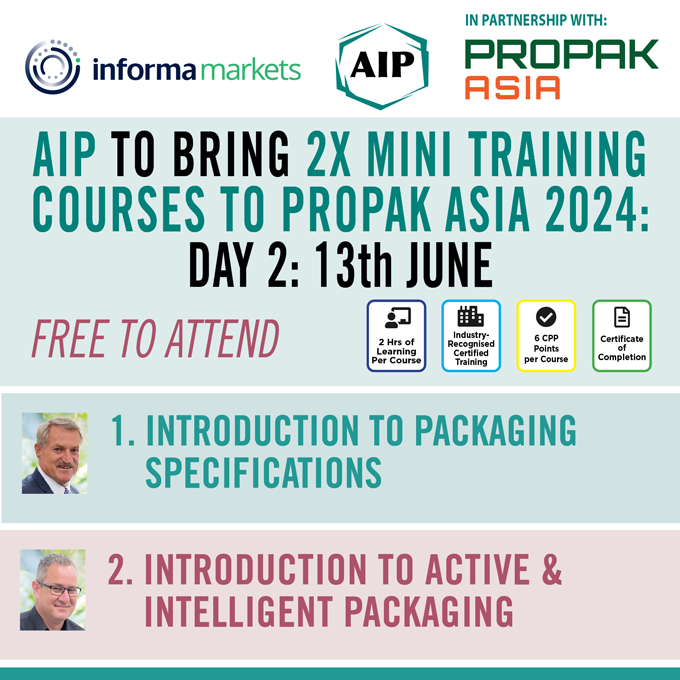
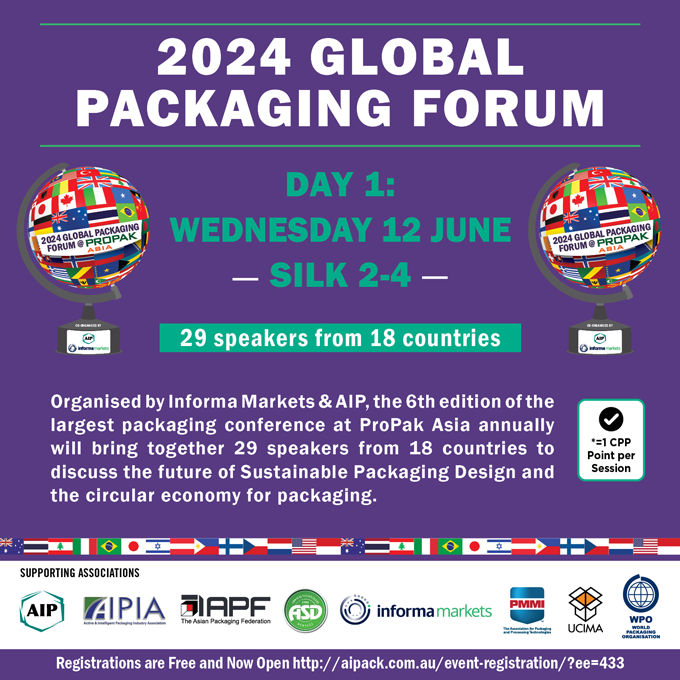
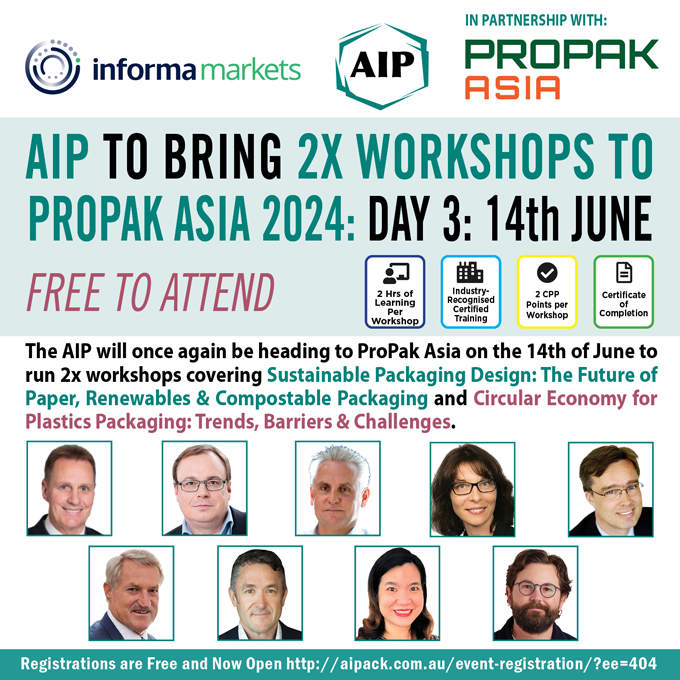
New President of the Italian Packaging Institute
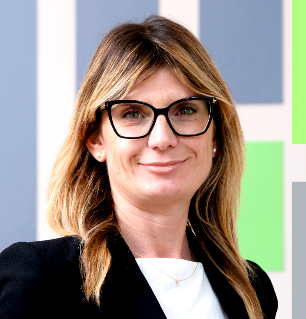 The Assembly of members of Istituto Italiano Imballaggio (www.istitutoimballaggio.org), a WPO member,
reconfirmed Alessandra Fazio at the head of the association for the 2024-2026. The Assembly of members of Istituto Italiano Imballaggio (www.istitutoimballaggio.org), a WPO member,
reconfirmed Alessandra Fazio at the head of the association for the 2024-2026.
During the event, Alessandra Fazio retraced the goals and
results of her first tenure, focusing on the issues of communication, through
digital marketing and social channels, PR activities and the strengthening of
relations with other stakeholders in the supply chain, particularly in the
international overview.
The actions undertaken included strengthening investment in
the LinkedIn channel, a structured presence at trade fairs and a close
collaboration with the packaging associations worldwide, as WPO.
Moreover, the Italian Institute of Packaging recently joined
Europen, an important step to provide the Italian Institute with resources,
knowledge, and a platform for influence that can significantly enhance its
mission and capabilities.
Another topic closely followed by the President is the
professional training. In the last two years, the Institute recorded
interesting numbers in its training programs: 3,586 participants in more than
3,100 hours. In addition, 10 new courses and workshops were launched.
The third core topic regards the assistance to the members.
The strategy for the next two years is to be engaged on new issues such as
scientific support to advocacy activities, quality standards and
sustainability, monitoring and analysis of new market trends, and expansion of
the membership base, in particular in the less represented sectors, such as
cosmetics and luxury.
Arab StarPack honors winners in Egypt
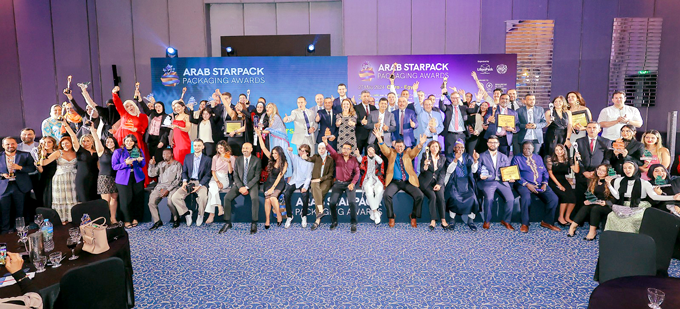
The winners of Arab StarPack, a packaging competition
recognized by WPO and organized by its member LibanPack (www.libanpack.org), were awarded during a ceremony held in
Egypt for the ocasion of Propak MENA.
Around 300 people from Arab and African countries attended
the ceremony, including many industrialists, companies, students, and
representatives of Arab and African packaging organizations, as well as the
President of the WPO, Luciana Pellegrino, and several representatives from Arab
embassies in Egypt. The ceremony counted with the support of UNIDO and Informat
Markets.
Arab StarPack aims to raise awareness about the latest
developments and trends in the packaging sector, particularly from marketing
and sustainable development perspectives, to enable Arab companies and students
to enhance the competitiveness of the food industries and other sectors in our
region.
Soha Atallah, Director of LibanPack and Vice President
Marketing of WPO, emphasized the importance of the competition, pointing out
that it aims to stimulate creativity and perseverance. She added that the 12
companies that won the Arab StarPack competition also participated in the
WorldStar, the global competition organized by the WPO.
During the ceremony, Luciana Pellegrino, WPO President,
expressed her delight in participating for the first time in the Arab StarPack
celebration, commending the membership of Arab and African countries in the
Organization.
More than 600 students and 160 Arab companies from 08
countries – Lebanon, Egypt, Tunisia, Palestine, Jordan, Oman, the United Arab
Emirates, and Saudi Arabia - participated in the Arab Star Pack competition. To
know all the winners, visit www.arabstarpack.org.
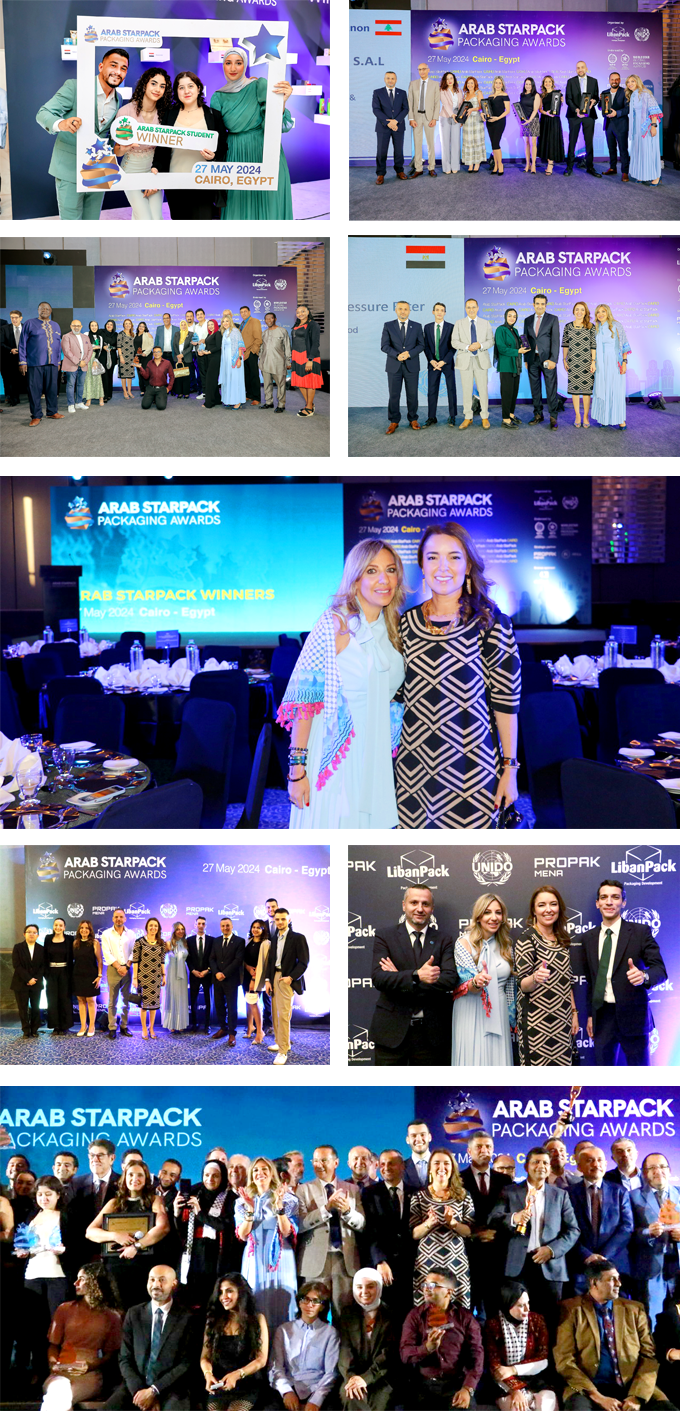
CENEM elects new Board of Directors
On June 18, WPO member in Chile, CENEM (www.cenem.cl),
held its Annual General Assembly with voting to select the Board of Directors
for the 2024-2028 period. Pamela Pavez, Chair of the CENEM Board of Directors,
led the meeting alongside Mariana Soto, General Manager of the Corporation.
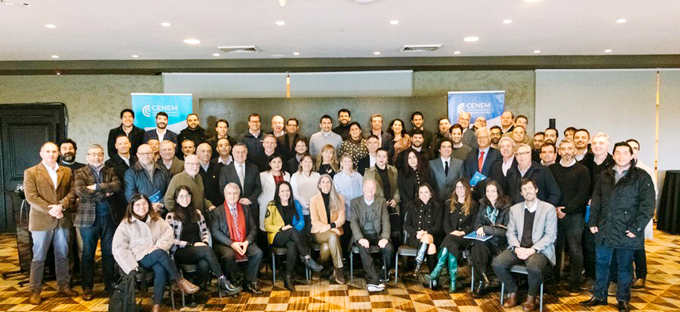
During the Assembly, the work carried out during 2023 was
reported, the Corporation's Financial Statement was presented, and the balance
for the 2023 fiscal year was approved. The Accounts Review Committee was
appointed, consisting of Erika León, General Manager of Sorepa, Jorge Fuentes,
General Manager of Siegwerk Chile, and Sara Navón, Sales Manager of Oxiquim.
A total of 12 candidates to be part of the Board of
Directors were presented, and the seven who received the most votes became part
of the Board for the next 4 years. They are: Pamela Pavez (Chilempack); Alfredo
Gili (CMPC Biopackaging Corrugados); Gino Villanueva (Amcor); Macarena Obach
(BO Packaging); Diego Vial (Sun Chemical); Fernando Álvarez (Packaging Xpert);
and Guillermo Toro (Cristoro).
Ukrainian competition for the Best Packaging
This year, 40 samples of packages and labels, from 22
companies, from eight Ukrainian cities, took part in the local competitions
‘Ukrainian Packaging Star’, ‘Ukrainian Label’ and ‘Packaging of the Future’,
all organized by WPO member, Club Packagers of Ukraine (www.upakjour.com.ua or www.packinfo.com.ua).
Companies from Latvia also took part in the competition for
the second time. 32 packaging samples and 10 label samples developed by young
designers, from seven universities and academies, from five cities of Ukraine,
were submitted to the ‘Packaging of the Future’.
The online jury meeting was held in April and joined well-known
packaging specialists from Ukraine and abroad. The results were: 03 awards to
Gualapak Ukraine, and 02 for each one of the following companies: Univest
Marketing LLC (Fastiv city), Kaskad (Dnipro city) and TCD (Kyiv city). Other
winners of the competition represented other parts of Ukraine.

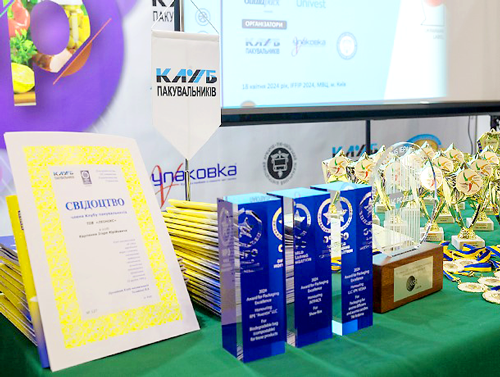
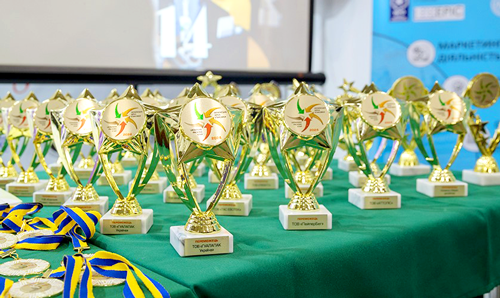
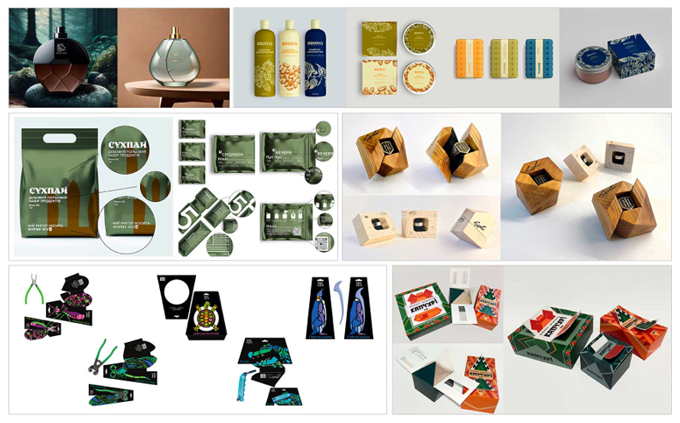
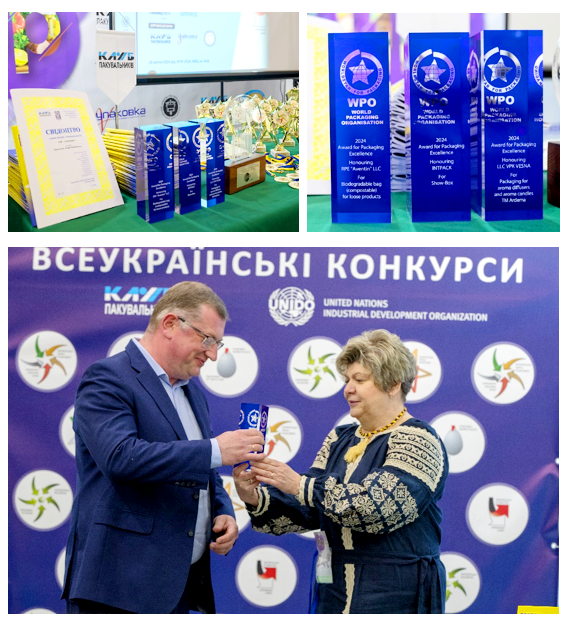
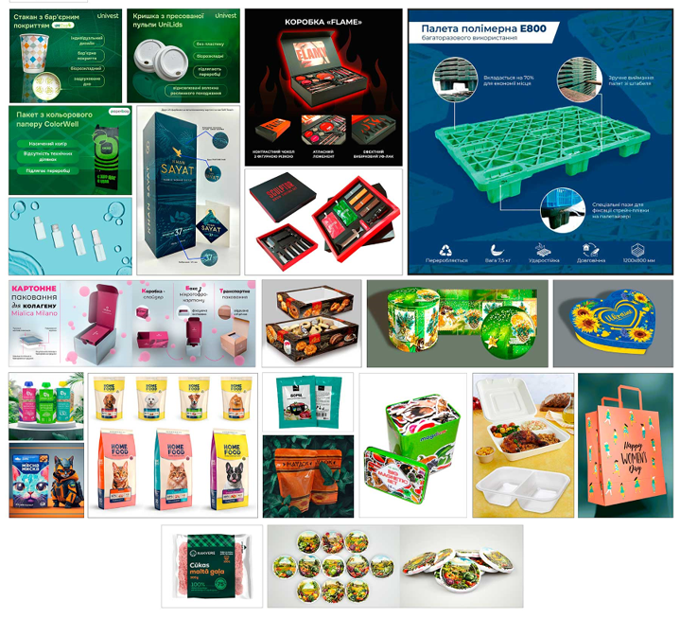

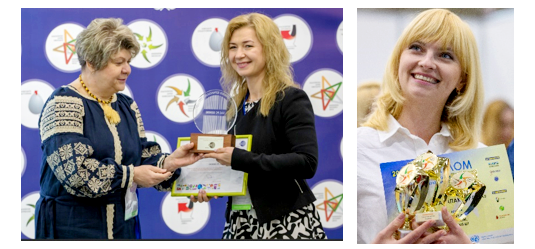
AgroFood Plastprintpack exhibition in partnership with APECI
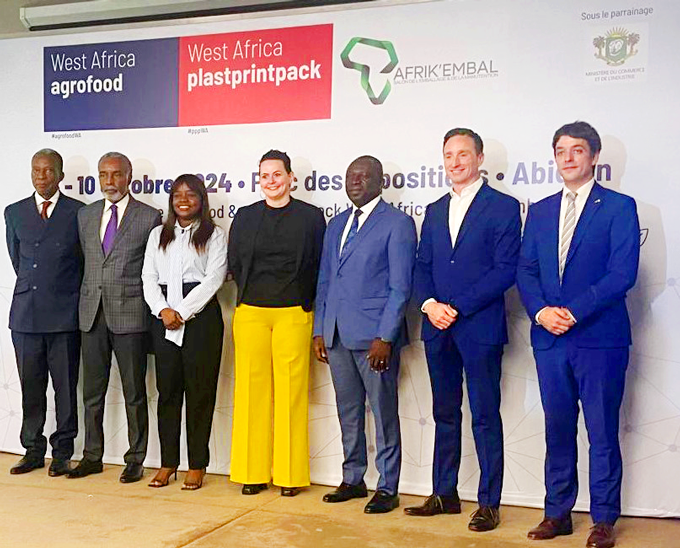
WPO member, Association of Packaging Professionals in Côte
d’Ivoire (APECI – www.apeci.ci), is a co-organizer of the
upcoming AgroFood – PlastPrintPack West Africa exhibition (Abidjan - October
08-10), under the theme: ‘Food safety, Food waste reduction, Recycling and
Circular Economy’. The exhibition is organised
by Fairtrade Messe and APECI will develop the concept
‘AfrikEmbal’.
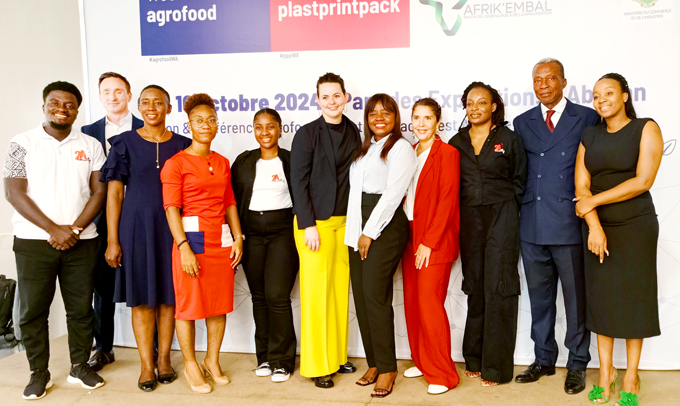
The idea is to showcase the entire value chain, from agro
business transformation to packaging, enabling the main local, regional and
international packaging players to meet, trade and network during the
three days show in the Ivory Coast. It is also a good opportunity to discover
global best practices in order to improve packaging developments and deliver excellent
products that are both consumers and environment-friendly.
A new cross border platform in China
 WPO member in China, World Packaging Center (GPC), is proud
to introduce its new cross-border platform, the World Packaging Cloud (WPC). It
focuses on Southeast Asia and the purpose is to help China's packaging
machinery and printing equipment, packaging containers, and auxiliary material
companies to go overseas and deliver high-quality products to global packaging
users. WPO member in China, World Packaging Center (GPC), is proud
to introduce its new cross-border platform, the World Packaging Cloud (WPC). It
focuses on Southeast Asia and the purpose is to help China's packaging
machinery and printing equipment, packaging containers, and auxiliary material
companies to go overseas and deliver high-quality products to global packaging
users.
Well done in the ScanStar!
WPO congratulates its members in the Nordic region - Sweden,
Finland, Norway, Denmark and Iceland - for the record of entries in the
ScanStar (www.scanstar.org) packaging competititon that
qualifies for the WorldStar Awards, the WPO global packaging award.
The jury meeting was hosted by WPO Vice President
Governance, Magnus Sidling, and member from Sweden, Mikael Gällstedt.
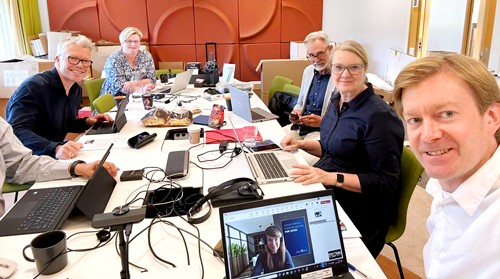
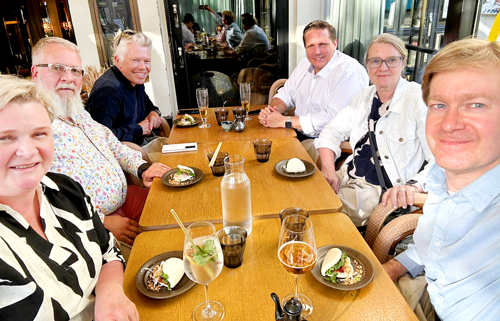
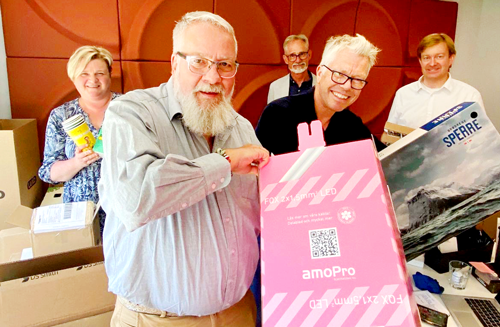
From the Board
From Thailand to Cuba!
WPO Global Ambassador, Silvio Colombo, from Argentina, flew directly from Propak Asia, in Bangkok, to Havana, to be the trainer in the packaging training course organized by WPO member from Cuba, the National Center for Containers and Packaging (CNEE).
As part of WPO packaging training programs, coordinated by Vice President of Education, Kofi Essuman, there are still 03 more scheduled to the second part of 2024: Kenya, Italy and Philippines. For more information, visit WPO webpage www.worldpackaging.org.
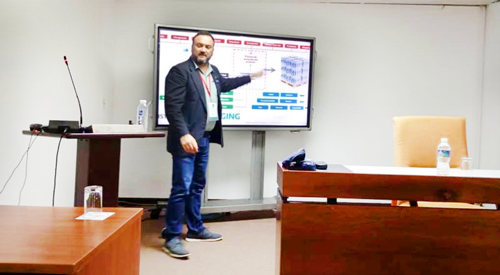
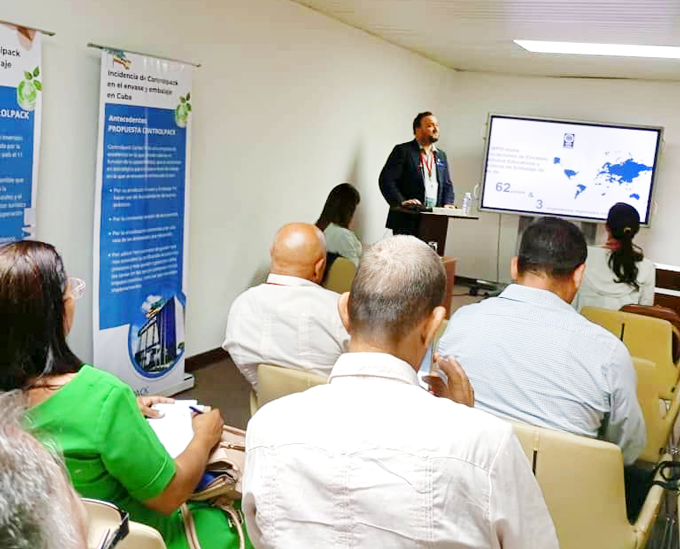
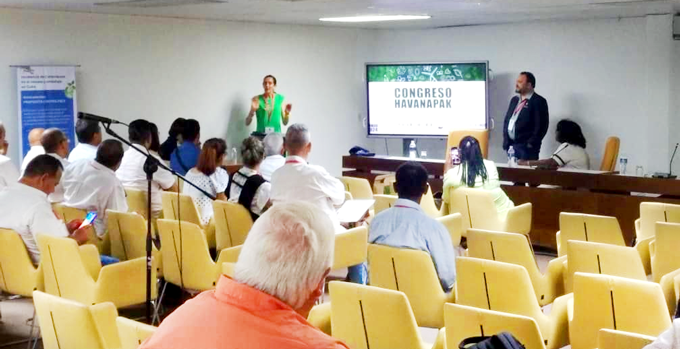
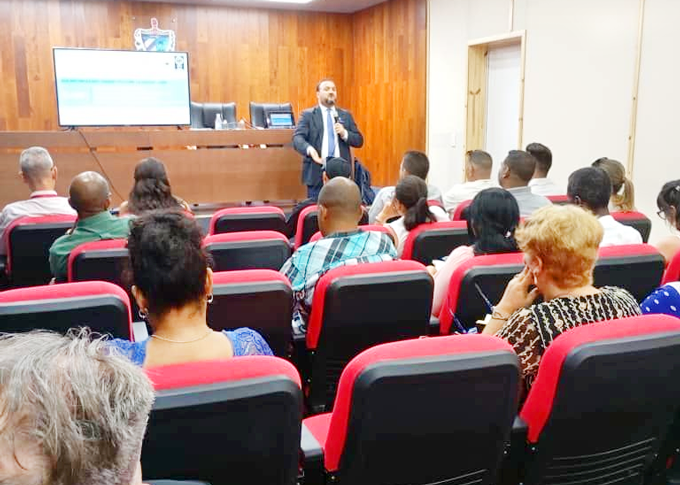
WPO visit to IAEA facilities
On June, WPO held a meeting, in cooperation with UNIDO (www.unido.org),
at the International Atomic Energy Agency (IAEA – www.iaea.org)
facilities in Seibersdorf (Austria). On that occasion, the WPO delegation got
to know the Food Safety and Control laboratory and discussed the opportunities
for future cooperation between the organizations.
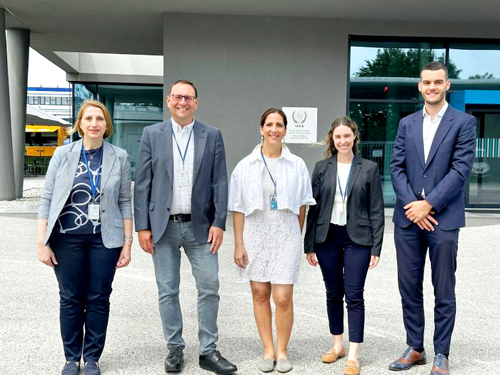
WPO was represented by its General Secretary, Johannes
Bergmair, and the Secretariat, Nathália Antoniazzi, that met Aleksa Mirkovic,
from UNIDO, and Christina Vlachou and Giselle Ruiz de Neumayr, from IAEA.
Well done Nerida!
WPO congratulates its Vice President Sustainability &
Save Food, Nerida Kelton, that was awarded with the inaugural Hall of Fame
Women in Packaging for Australia and New Zealand. She was recognized for being
a “trailblazer and mentor for women in the region”.
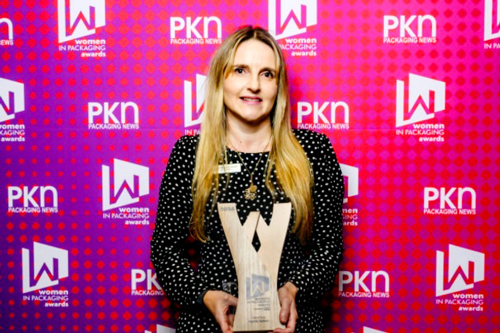
WPO member, the Australian Institute of Packaging (AIP – www.aipack.com.au) supported the inaugural Women in Packaging
Awards powered by the local publication, PKN Packaging News.
Future plans with Hispack, in Spain.
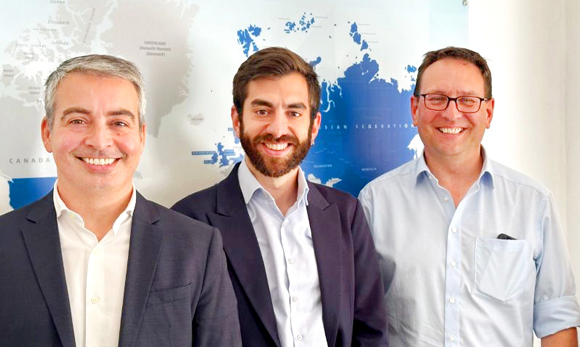
Also on June, WPO received in its headquarters in Vienna,
the visit of the representatives of Market AAD, a consultancy company that
supports Hispack (www.hispack.com), in the organization of
conferences and content events at the packaging show in Spain.
WPO General Secretary, Johannes Bergmair, hosted Ricard
Madurell and Adrià Llacuna. On the occasion, they discussed WPO's future
contribution and cooperation to the next edition of Hispack.
Education
Packaging program in UK
WPO member in UK, IOM3 (www.iom3.org), offers
a range of courses to help upskill those in the packaging industry. The
courses cover a wide range of topics and are suitable for those just starting
out in the industry or simply wanting to expand their knowledge, or to those
wishing to undertake learning in specific areas of packaging technology.
Many of our courses are available in person or as online
distance learning, and lead to recognised qualifications from PIABC. Online
learners can start our online PIABC Level 3 Certificate in Packaging and EQUIPT
courses at any time.
Please note that the note that the next intake for our PIABC
Level 5 Diploma in Packaging Technology blended learning course is 23 October
2024.
For a full list of packaging technology and packaging
industry courses, go to: https://bit.ly/iom3packaging.
News from Corporate Partners
TNA announces ‘Packed with Purpose’ initiative to support
children’s education in disadvantaged communities

In an unprecedented event to raise funds to enhance the
lives of children in disadvantaged communities, WPO Corporate Partner, TNA
Solutions (www.tnasolutions.com), presents ‘Packed with
Purpose’, a unique giveaway that gives entrants an unbelievable 1 in 200 chance
to win the tna robag® worth USD 200,000. The initiative is under the company´s
philanthropic arm, the Nadia and Alf Taylor Foundation.
To participate, the first 200 people will have the
opportunity to donate the equivalent to USD 1,500 or more, after which the
entries will be closed and 100% of the proceeds will be given directly to fund
deserving projects.
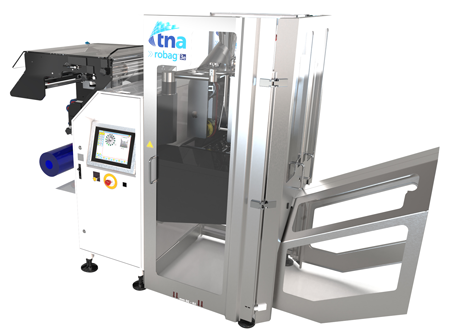 The grand prize draw will take place on 25 July 2024, and
the winner will receive the world’s fastest VFFS solution, the tna robag®. The
equipment offers unrivalled speeds of up to 250 bags per minute combined with
wastage as low as 0.1%. It provides superior flexibility and enhanced
serviceability for maximum up-time, and bags just about any type of food
application faster and more efficiently than anyone else. The grand prize draw will take place on 25 July 2024, and
the winner will receive the world’s fastest VFFS solution, the tna robag®. The
equipment offers unrivalled speeds of up to 250 bags per minute combined with
wastage as low as 0.1%. It provides superior flexibility and enhanced
serviceability for maximum up-time, and bags just about any type of food
application faster and more efficiently than anyone else.
Dave Everett OAM, CEO of the Nadia and Alf Taylor
Foundation, said: “At a 1 in 200 chance, the odds of winning the tna robag® are
unbelievable! The important point here is that by donating, you are making a
big difference to underprivileged children around the world who would otherwise
go without the chance of a decent education. There is no downside that we can
see, just a chance to contribute directly to a great cause and win TNA’s market
leading packaging system in the process.”
If the target is not reached, the Foundation will refund the
donations.
Worldstar Awards
WorldStar Award and WorldStar Student
Ceremony 2024 celebrated the global packaging excellence in Bangkok
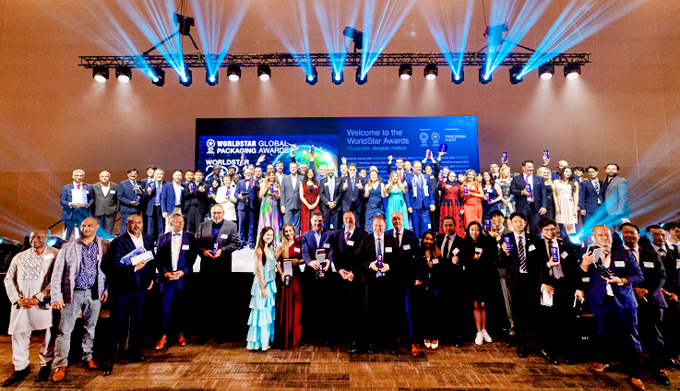
WPO organized the prestigious WorldStar
Awards and WorldStar Student Award Ceremony and Gala Dinner during ProPak Asia
2024, on June 15. The event was hosted by the show organizer, Informa Markets
Asia, and was attended by around 300 packaging professionals from 42 countries
and WPO Board Members, counting as well with Informa Markets and UNIDO
representatives. Once again, WorldStar and WordStar Student entries showcased
the pinnacle of innovation and dedication in the packaging industry.
The evening kicked off with an authentic
cultural performance, celebrating the rich heritage of Thai culture. Besides
the 90 winners present in the Ceremony, representing 77 companies across 31
countries, the night also awarded two winners of WorldStar Student, from Ghana
and the USA, and the Lifetime Achievement Award in Packaging, delivered to
Gyorgy Viskel, from Hungary, honoured for his lifelong contributions to the
packaging industry.

The WorldStar Special Categories were also
acknowledged during the night as the best packaging innovations in
Sustainability, Packaging that Saves Food, and Marketing. Last but not least,
the President’s Award was presented by WPO President, Luciana Pellegrino,
celebrating the most innovative and impactful packaging solution.
Luciana Pellegrino expressed her pride and
vision for the future stating: “The WorldStar Awards ceremony celebrates the
best of the best in packaging innovation from around the globe. And a special
evening like this, gathering the global packaging community, strengthens our
industry and inspires us push collaboration and solutions for a greater
positive impact.”
Soha Atallah, WorldStar Coordinator and WPO
Vice President for Marketing also shared her excitement, saying: “It is an
honour to LibanPack to organize the WorldStar, on behalf of WPO, for the third
consecutive year. Seeing the pride and the bright shine in the eyes of the winners
makes all the efforts worthwhile. This year, we celebrated the 56th edition of
WorldStar and we are thrilled to have it in the vibrant city of Bangkok, during
Propak Asia.”
Both Luciana Pellegrino and Soha Atallah
expressed their appreciation for Informa Markets team for hosting WorldStar
Ceremony and for their warm hospitality for WPO activities – Board Meeting,
Working Groups and Executive Meeting – for a week (June 10-15), during ProPak
Asia.
The complete list of WorldStar Winners is
available on WorldStar website www.worldstar.org and
the list of WorldStar Student is available at www.worldstarstudent.org.
The new edition for Worldstar 2025 was
opened for entries on July 10, 2024. For more information
on WorldStar Awards, contact the Coordinator, Soha Atallah, by e-mail [email protected].
Trends Report
WorldStar Awards and WorldStar Student Packaging Trends
Report is available for download!
The latest edition of the WPO Packaging Trends Report, based
on the winners of WorldStar Awards 2024 (www.worldstar.org) and
WorldStar Student (www.worldstarstudent.org)
2024, is available for free download in WPO webpage www.worldpackaging.org.
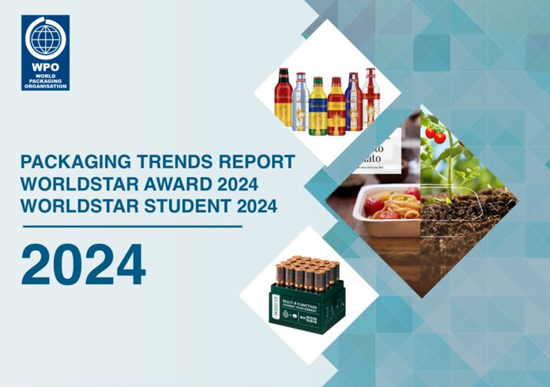
The document includes, among other details, the global
packaging trends for 2024:
- Consumer Awareness & Preferences
- Single-Use Plastics Regulations
- Extended Producer Responsibility
- Recycled Content Requirements
- Labeling Legislation
- Design for Recovery
- Substance Restrictions
The Report also analyzes each WorldStar category and
connects them with the main trends identified in the winning packages. The
Packaging Trends Report was produced by WPO Press & Communication Liaison
Officer, Liliam Benzi.
Special Interview – Pierre Pienaar
The importance of being the first Lifetime
CPP in Australasia 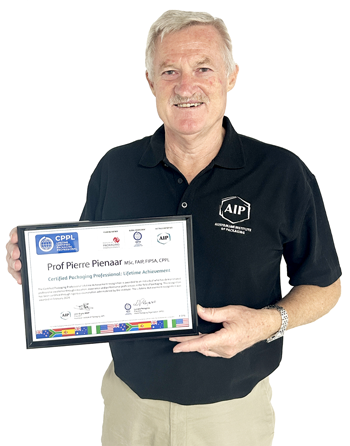
The AIP (Australian Institute of Packaging
– www.aipack.com.au), a WPO member, congratulates the recipient
of the first Lifetime Certified Packaging Professional in Australasia, Pierre
Pienaar MSc FAIP, FIPSA, CPPL, Education Director, AIP and former WPO President.
Let´s hear what he has to say about the CPP
program that has been accepted as the global recognition as a packaging
professional and has become the leading mark of excellence internationally, and a must-have recognition of industry proficiency and
achievement for packaging professionals.
1. How long have you been in the
industry? What are your areas of expertise?
Pierre: I commenced in the industry in
1984 after studying pharmacy and joining a large pharmaceutical manufacturer.
After a year of doing drug analysis an offer came up to become involved in
packaging. I jumped at the opportunity of getting out of the laboratory and
venturing into the world of packaging. I was asked by the CEO to find a
university somewhere in the world to do a post graduate degree in Packaging. I
found Brunel University in London where I completed a Master’s Degree in
Packaging Engineering.
It is because of my undergraduate studies
that I have developed an affinity for pharmaceutical packaging. I enjoy
packaging problem solving in a production environment because in my early years
in pharma where I spent 6 years in the manufacturing of liquid, parentals and
solids and where the packaging was diverse and there was lots to learn in
packaging when it came to output on the diverse filling machines. It was during
these years in production that I completed a Master’s Degree in Production from
University of Hertfordshire, UK.
2. What made you originally
apply for the Certified Packaging Professional (CPP) Designation?
Pierre: Whilst involved in the WPO as Vice
President Education, I wanted the WPO to have an international recognised
accreditation because we had no idea of the various qualifications of the wide
variety of people involved in the WPO. At that time, the WPO President, Tom Schneider,
tasked me to find such a reputable accreditation that would fit with the needs
of the WPO and was internationally recognised. At the same time, the AIP was
also in discussions with IoPP (Institute of Packaging Professionals – www.iopp.org),
WPO member in the USA, to launch the program into Australasia.
WPO used the AIP development of the program
as a test case for how it could work for the rest of the world. The WPO program
was borne out of the AIP program. At this early stage, the AIP became involved
in supporting the development of the WPO program and they became first
association to offer the CPP outside of the USA. I attained my CPP through the
AIP and I became the first person to become a CPP in Australasia. The AIP had
the tenacity to become the first association to offer the program for
Australasia and they now have many CPP's in the region and support those around
the world to undertake the designation.
3. Why was it so important for
you to attaining the CPP designation?
Pierre: It is important that when the
global packaging community comes together, we can easily recognise other
professionals that are equally qualified in the various disciplines in
packaging. The CPP designation gives us all a sense of belonging to a bigger
global community.
Recognition however must go to the AIP for
all of their hard work in becoming the first association outside of the IoPP to
offer the program and for taking the lead in the WPO Members. The AIP supports
the WPO CPP program and works with many people around the world today to help
guide them to attain the designation. In fact, the General Secretary of the WPO,
Johannes Bergmair, undertook his CPP through the AIP.
4. How important is the CPP
designation for the greater recognition of people in the packaging industry?
Pierre: It is the ultimate and only method
of ensuring that you are recognised internationally in the packaging industry,
through this CPP accreditation program. The CPP is also recognised in over 64
WPO Member countries which will help you to look for jobs overseas. Just
knowing this is so encouraging and inspiring.
5. Were there any new learnings or
takeaways that you gained from the experience?
Pierre: It has reminded me just how
diverse packaging really is, all encompassing, where the left and right brain
is required to solve the myriads of options and opportunities. It is a field
where on-going studying and learning, be that in conferences, classroom,
reading, discussions, webinars, seminars are all truly necessary, so as to stay
abreast of developments.
6. What does it feel like to be the first
Lifetime CPP in Australasia?
Pierre: If it inspires others to gain
their CPP in packaging, then it has been worthwhile. Like anything there always
has to be a first, I just happened to be in the right place and at the right
time and nudged at the beginning by Nerida Kelton to attain the CPP
designation.
7. What advice would you offer anyone in
the industry looking to become a Certified Packaging Professional?
Pierre: What has driven me is to ensure
that growth in education persists. It is encouraging to witness this
enhancement and growth of the packaging industry over these ensuing years.
This highly regarded Certified Packaging
Professional (CPP) program is really gaining momentum across all nations in the
packaging professional space. The AIP is intentional about education and
ensuring that it remains current giving the industry the advantage of access to
cutting-edge packaging developments globally, and the CPP program is part of
that education.
If your intention is to remain in the packaging
industry, and you want to ensure on-going learning, then the CPP program is for
you. It certainly gives you a sense of belonging and a great personal sense of
achievement.
Attaining the CPP designation is an
excellent investment in your professional development and the credential
defines the packaging professional and allows organisations to seek out and
hire the right professional based on verified knowledge, skills and industry
contributions. Using the CPP program to assess and evaluate one’s professional
competency validates you as internationally proficient as a packaging
professional; a cut above your peers.
Special Article – Sustainability
Standout sustainable packaging at Anuga
FoodTec 2024
By Nerida Kelton*
For the first time, WPO decided to exhibit
and participate in three speaking sessions during Anuga FoodTec, a 04 days show
that joined almost 40,000 people, from 133 countries, in Cologne (Germany). On
the occasion, I had the opportunity to visit some of the exhibition stands,
talk to a number of exhibitors and see what is new, innovative, and intuitive.
I was particularly looking for packaging
that is recycle ready, offers improvements to packaging to provide lower
environmental impacts, new advancements in paper and renewable materials, and any
save food packaging design. And here is the result of my search!
SIG Alu Free cartons
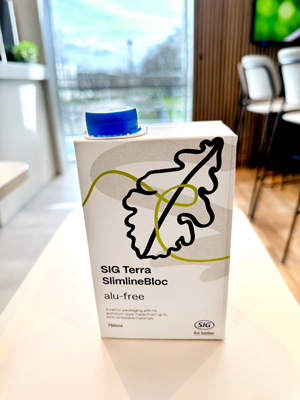 SIG Alu Free cartons are an aseptic carton
with no aluminium layer. The carton is FSC certified paperboard, is fully
recyclable and produced with 100% renewable energy. The SIG Alu free carton has
a carbon footprint up to 27% lower than standard SIG packaging material, thanks
to a unique composite with no aluminium layer. It is designed for liquid dairy
products such as plain white UHT milk, cream, and other oxygen-insensitive
products. The carton is made from up to 82% renewable paperboard, with
ultra-thin polymer layers to contain and protect products over long periods of
time without the need for refrigeration. SIG Alu Free cartons are an aseptic carton
with no aluminium layer. The carton is FSC certified paperboard, is fully
recyclable and produced with 100% renewable energy. The SIG Alu free carton has
a carbon footprint up to 27% lower than standard SIG packaging material, thanks
to a unique composite with no aluminium layer. It is designed for liquid dairy
products such as plain white UHT milk, cream, and other oxygen-insensitive
products. The carton is made from up to 82% renewable paperboard, with
ultra-thin polymer layers to contain and protect products over long periods of
time without the need for refrigeration.
SIG also recently added the option to link
to 100% forest -based renewable materials via a mass-balance system. The SIG
Alu free carton is another step to remove aluminium form aseptic cartons but
still maintain shelf life and barrier for products.
www.sig.biz
Sea6 Energy developing seaweed-based films
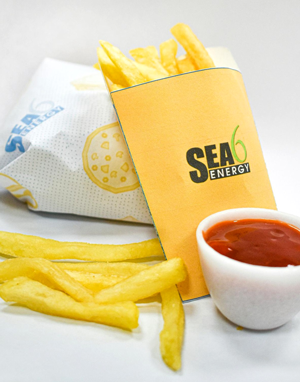 Seaweeds, characterised by their efficient
utilisation of solar energy and minimal resource requirements, offer a
promising solution to address the pressing challenges of resource scarcity and
environmental degradation. Seaweeds, characterised by their efficient
utilisation of solar energy and minimal resource requirements, offer a
promising solution to address the pressing challenges of resource scarcity and
environmental degradation.
Headquartered in Bangalore, Sea6 Energy
believes that there is a critical need to design innovation strategies to meet
the escalating demand for raw materials, particularly within the packaging
industry.
Sea6 Energy are developing seaweed based,
compostable films that can be used for packaging of FMCG goods and fast foods.
These films, when discarded into the environment, will compost in a few months
and are available in Food and Non-food grades.
The utilisation of seaweed biomass extends
beyond traditional boundaries, encompassing the production of bio stimulants
for agriculture and horticulture, food and feed ingredients, and the
development of innovative biomaterials tailored for the packaging industry.
Sea6 Energy is actively engaged in research and development efforts to
formulate seaweed-derived biomaterials such as coatings, and extrusion
compounds for flexible films and rigids. These biomaterials offer several
advantages, including biodegradability, renewability, and reduced environmental
impact, positioning them as sustainable alternatives to traditional packaging
materials. The commercialisation of first materials is targeted within the next
12 months. I look forward to watching Sea6 Energy developments in the future.
https://www.sea6energy.com/solutions/bio-plastics/
PaperBoard – formable paper by Multivac
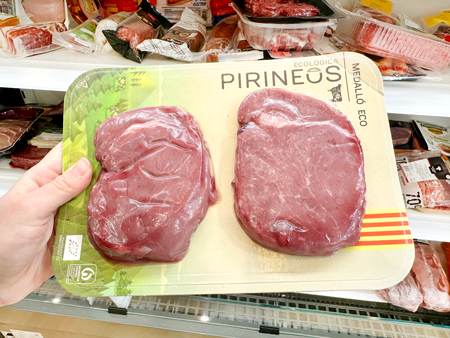 The PaperBoard series has been designed to
eliminate single use plastics, reduce the use of plastics and improve
recyclability of the packs. The material can be run on packaging systems in the
form of rolls, pre-cuts, or trays. Paper fibre and cardboard composites with
different grammages and functional layers are available. The use of functional
layers makes it possible to produce paper-based packs that meet the barrier
property requirements of the respective product. The PaperBoard series has been designed to
eliminate single use plastics, reduce the use of plastics and improve
recyclability of the packs. The material can be run on packaging systems in the
form of rolls, pre-cuts, or trays. Paper fibre and cardboard composites with
different grammages and functional layers are available. The use of functional
layers makes it possible to produce paper-based packs that meet the barrier
property requirements of the respective product.
What I personally like about the PaperBoard
series is that the design is a step ahead of many other available solutions in
the market for separability of the components for recycling. Many consumers get
frustrated by some of the packs on the market as they can’t easily separate the
film from the paper. This in turn means that the separable components end up in
the wrong disposal bin and the pack that has been promoted as reducing single
use plastic and being more sustainable is not meeting sustainable design
standards.
The PaperBoard design however does separate
easily as I tested multiple packs. The design features are intuitive and ensure
that the paper and the film can in fact be easily and quickly separated by a
consumer.
www.multivac.com
G. Mondini Paper2Skin
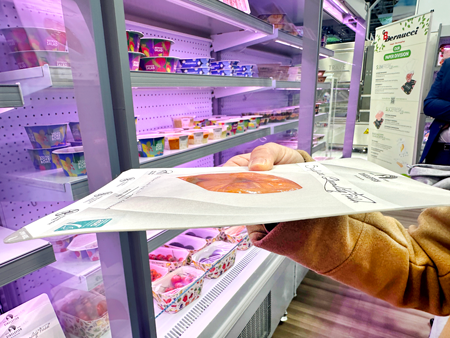 Another paper-based solution that I saw on
the G.Mondini stand was Paper2Skin which is a unique and innovative paper top
skin web technology designed to take packaging to the next level. The pack has
been designed to eliminate single use plastics, use less material at the start
and ensure that the materials can be separated and recycled easily. Another paper-based solution that I saw on
the G.Mondini stand was Paper2Skin which is a unique and innovative paper top
skin web technology designed to take packaging to the next level. The pack has
been designed to eliminate single use plastics, use less material at the start
and ensure that the materials can be separated and recycled easily.
The Paper2Skin material is FSC/PEFC certified,
is designed to be able to separate the components for recyclability and is
easily openable and separable for the consumer. The pack offers a uniquely
shaped window and the laser cutting of paper allows each brand to be able to
create several window shapes depending on the product shape and size.
https://www.gmondini.com/
Anuga FoodTec has always been on my bucket
list of global trade shows that I have wanted to see, and it did not
disappoint. Unfortunately, I didn’t get to see as many exhibition stands as I had
wanted as it is a very large exhibition with thousands of stands.
I have no doubt that there were many other
innovative packaging designs on display that I missed but the ones I have
mentioned are just some that I wanted to share with you.
If you are planning to attend the next
edition of Anuga FoodTec on the 23rd to 26th of February 2027 I would recommend
that you allow at least two days to walk around the show. I also look forward
to returning to Anuga FoodTec in 2027 to see even more advancements in
sustainable packaging and recycle ready packs. Imagine what we will see in
three years!
*Nerida Kelton is Executive Director of WPO
member AIP (Australian Institute of Packaging – www.aipack.com.au) and WPO Vice President Sustainability &
Save Food [email protected].
Special Article – TNA
TNA revolutionises potato product supply
for the Egyptian Army
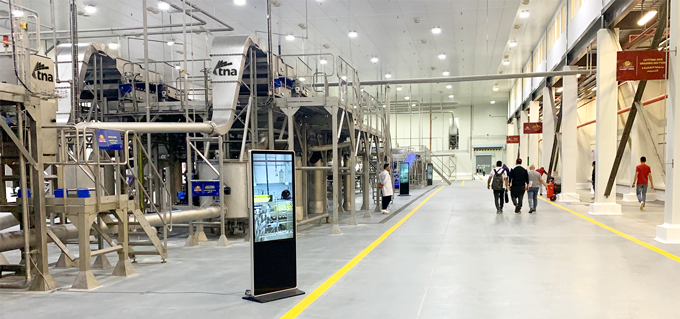
TNA Solutions (www.tnasolutions.com), a WPO Corporate Partner, has
implemented a ground-breaking project for the Egyptian Army. Tasked by the
Egyptian National Services Projects Organisation (NSPO) in 2020, TNA has
delivered two cutting-edge complete production lines for potato products. Specifically
designed for Hash Browns and Rosti, the first line is capable of producing two
metric tonnes per hour, while the second line, dedicated to French Fries,
wedges and disks, produces up to 10 metric tonnes per hour.
Production efficiency is maximised as TNA
provides every element of the production process, from potato washing and
de-stoning to packing products in bags. In addition, TNA’s unrivalled expertise
has enabled the integration of state-of-the-art distribution and arctic
packaging systems, specifically tailored for frozen potato products.
In collaboration with Optima Solutions,
formerly Getec Partners LLC, TNA secured this prestigious contract to support
the Egyptian Ministry of Defence in achieving self-sufficiency in meeting the
needs of the armed forces, the local markets, and export products. TNA’s
industry-leading reputation for delivering exceptional projects solidified its
position as the chosen partner. The project was a true testament to the
dedication of TNA’s solutions specialists and global team of experts.
The Egyptian President, Abdel Fattah
El-Sisi, championed an inaugural ceremony at the factory, at which he
emphasised unwavering commitment to advancing the industrial landscape in
Egypt, simultaneously advocating for the preservation and protection of the
environment and the implementation of eco-friendly factory designs.
Thiago Roriz, TNA’s Chief Operations
Officer, was invited to address the gathering. On behalf of TNA’s founders,
including co-founder & Director, Nadia Taylor, who takes immense pride in
her Egyptian heritage, Thiago expressed heartfelt gratitude to the President
and reaffirmed TNA's commitment to supporting the venture and sharing its
unparalleled expertise in potato production: “TNA is a leading provider of potato
production lines – having supplied more than 14,000 systems across 120
countries globally. We are proud to have an opportunity to support this project
and to offer expertise in food processing and packaging to deliver the highest
possible quality.”
TNA’s cutting-edge machinery,
state-of-the-art technology and extensive process experience empowered the
company to deliver the two complete lines on schedule, ensuring the efficient
production of premium worldwide quality products while adhering to energy
consumption, CO2 emissions and other sustainability related goals. Thiago
continued: “TNA is immensely proud and honoured to be an integral part of this
project. We extend our sincere appreciation to President El-Sisi, the Egyptian
government, and our trusted strategic partner, Optima Solutions, for making
this resounding success possible.”
The completion of both production lines in
June 2023 marks the beginning of a transformative era. Discussions are already
underway to expand operations to include new potato products, sweet potatoes
and the processing of various agricultural products. As
TNA continues to spearhead innovation, its new solutions are set to reshape the
potato processing industry, improving efficiency, quality and sustainability.
Special Article
Smart packaging technologies: enhancing product
traceability, consumer engagement, and supply chain transparency.
By Jopack, WPO member in Jordan*

Smart packaging, an innovative intersection
of packaging and technology, is transforming how products are tracked,
consumed, and managed across the supply chain. Incorporating NFC tags, QR
codes, and sensors into packaging offers sophisticated solutions that improve
product authenticity, consumer interaction, and operational transparency. This
paper delves into the mechanisms, benefits, and implications of these
technologies in modern packaging systems.
Mechanisms of smart packaging technologies
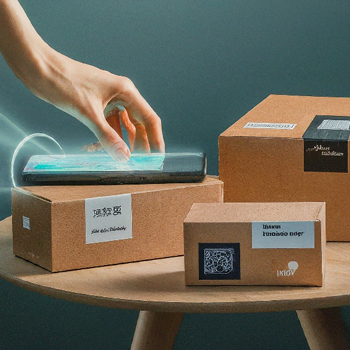 NFC Tags NFC Tags
NFC technology allows for wireless
communication between the packaging and a smartphone or NFC reader. NFC tags
embedded in packaging can store information such as production dates,
ingredient sourcing, and logistical data. When consumers scan these tags with
their smartphones, they gain instant access to this information, thereby
enhancing product authenticity and transparency.
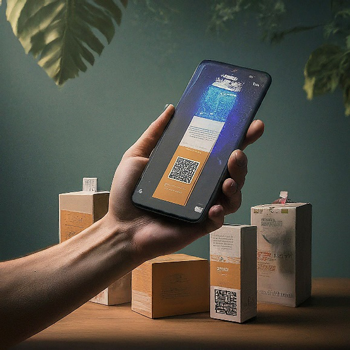 QR Codes QR Codes
QR codes are two-dimensional barcodes that
can be scanned by a smartphone to retrieve data stored within the code. These
codes can link consumers to websites that provide detailed product information,
including manufacturing processes, shipping history, and storage conditions. QR
codes serve as a bridge between physical products and digital information,
facilitating comprehensive product tracking and consumer engagement.
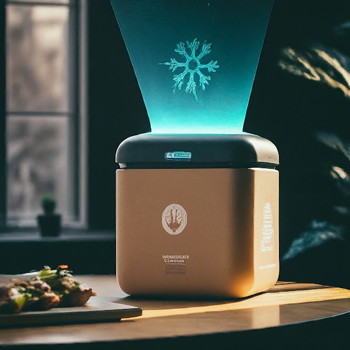 Sensors Sensors
Sensors integrated into packaging can
monitor and report real-time conditions such as temperature, humidity, and
light exposure. These sensors help in maintaining the quality and safety of
perishable goods by alerting stakeholders to any deviations from optimal
storage conditions. Sensor data can be transmitted to supply chain managers,
ensuring proactive measures are taken to prevent spoilage and maintain product
integrity.
Benefits of smart packaging technologies
Enhanced product traceability
Smart packaging technologies enable precise
tracking of products from production to consumption. NFC tags and QR codes
provide a digital trail that can be monitored in real-time, ensuring that
products reach consumers in the intended condition. This traceability is
crucial for quality control, inventory management, and regulatory compliance.
Improved consumer engagement
By offering interactive experiences, smart
packaging technologies increase consumer engagement. NFC and QR code-enabled
packaging can provide access to promotional content, usage instructions, and
loyalty programs. This not only enhances the consumer experience but also
strengthens brand loyalty and drives repeat purchases.
Supply chain transparency
Smart packaging contributes to greater
transparency within the supply chain. Sensors provide real-time data on
environmental conditions during transit, allowing companies to ensure that
products are handled correctly. This transparency helps in identifying and
addressing issues promptly, reducing waste and improving overall supply chain
efficiency.
Challenges in implementing smart packaging
Cost implications
The integration of smart technologies into
packaging can be costly. The initial investment in NFC tags, QR codes, and
sensors, along with the necessary infrastructure for data management, can be
significant. These costs may be prohibitive for smaller companies, limiting the
widespread adoption of smart packaging technologies.
Technical and logistical barriers
Implementing smart packaging requires
overcoming technical challenges related to data security, interoperability, and
scalability. Ensuring that the technology works seamlessly across different
platforms and environments is critical for its success. Additionally,
logistical challenges such as maintaining the readability of QR codes and NFC
tags under various conditions must be addressed.
Future directions
The future of smart packaging looks
promising, with ongoing advancements in the Internet of Things (IoT) and
artificial intelligence (AI) poised to further enhance its capabilities. Emerging
technologies such as blockchain can complement smart packaging by providing
immutable records of product history, thereby further improving traceability
and trust. Moreover, as the cost of smart technologies decreases, their
adoption is expected to become more widespread, driving innovation and
efficiency in the packaging industry.
Conclusion
Smart packaging technologies represent a
significant leap forward in the packaging industry, offering innovative
solutions that enhance product traceability, consumer engagement, and supply
chain transparency. While challenges related to cost and implementation exist,
the benefits of smart packaging are substantial and
far-reaching. As technology continues to evolve, smart packaging is set to play
a pivotal role in shaping the future of product management and consumer
interaction.
*Jopack (Jordan National
Packaging Center – www.jopack.org) is a WPO member.
For more information, contact Sarah Hudaib, Project Manager & Testing
Technician, by e-mail [email protected].
Special Article
Packaging for e-commerce: balancing protection,
cost, and sustainability
By Jopack, WPO member in Jordan*
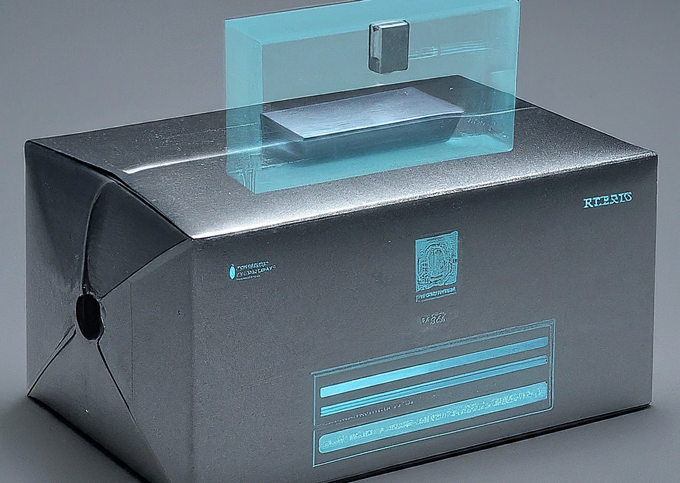
E-commerce has transformed the retail
landscape, offering consumers convenience and a wide range of products at their
fingertips. However, this shift has also brought new challenges in packaging.
Unlike traditional retail, e-commerce requires packaging that can withstand the
rigors of shipping while maintaining cost-effectiveness and environmental
sustainability. This article delves into the critical aspects of e-commerce
packaging, exploring strategies to achieve an optimal balance between
protection, cost, and sustainability.
Challenges in e-commerce packaging
1. Protection
Impact resistance – Products sold online must
be packaged to withstand various physical stresses during transit, including
handling, stacking, and transportation. Insufficient protection can lead to
product damage, resulting in customer dissatisfaction and increased return
rates.
Environmental factors – E-commerce packages
are exposed to varying environmental conditions such as temperature
fluctuations and humidity. Packaging materials must be chosen to protect
products against these factors, ensuring they arrive in perfect condition.
2. Cost
Material costs – The choice of packaging
materials significantly impacts the overall cost. While premium materials offer
better protection, they can be expensive. Finding a cost-effective solution
that does not compromise on quality is essential for maintaining profit
margins.
Shipping costs – E-commerce packaging must
also consider dimensional weight pricing. Bulky or heavy packages incur higher
shipping costs, making it crucial to design packaging that is both lightweight
and compact without sacrificing protection.
3. Sustainability
Environmental impact – With increasing
consumer awareness of environmental issues, there is a growing demand for
sustainable packaging solutions. Businesses must balance the need for
protective packaging with the imperative to reduce their environmental footprint.
Regulatory compliance – Various regulations
and guidelines mandate the use of sustainable materials and practices in
packaging. Companies must stay compliant with these regulations while meeting
their operational needs.
Opportunities in e-commerce packaging
1. Innovative materials
Biodegradable and recyclable materials – Innovations in materials science have led to the development of biodegradable
and recyclable packaging materials. These options reduce environmental impact
while providing adequate protection for products.
Lightweight alternatives – New lightweight
materials, such as molded pulp and air pillows, offer protection without adding
significant weight. These materials can help reduce shipping costs while
maintaining product integrity.
2. Smart packaging
Track and trace – Smart packaging
technologies, such as RFID tags and QR codes, allow for real-time tracking of
shipments. This enhances transparency in the supply chain and improves customer
satisfaction by providing accurate delivery information.
Temperature control – For perishable goods,
smart packaging with temperature sensors can monitor and maintain optimal
conditions, ensuring product quality upon arrival.
3. Customization and branding
Personalized packaging – E-commerce provides
an opportunity for businesses to use packaging as a branding tool. Customized
packaging that reflects the brand’s identity can enhance the unboxing
experience and build customer loyalty.
Eco-friendly branding – Emphasizing
sustainability in packaging design can attract environmentally conscious
consumers. Using recycled materials and highlighting eco-friendly practices in
branding can differentiate a company in the competitive e-commerce market.
Strategies for balancing protection, cost,
and sustainability
1. Design optimization
Minimalist design – Adopting minimalist
design principles can reduce material usage and waste. This involves designing
packaging that uses the least amount of material necessary while still
providing adequate protection.
Right-sizing – Right-sizing packaging to fit
the product snugly minimizes excess space, reducing the need for additional
protective fillers and lowering dimensional weight for shipping.
2.
Material selection
Hybrid solutions – Combining different
materials can optimize the balance between protection, cost, and
sustainability. For example, using a sturdy outer layer with a biodegradable
inner layer can offer both protection and environmental benefits.
Recycled content – Incorporating recycled
content in packaging materials reduces the demand for virgin resources and
minimizes environmental impact.
3. Process improvements
Automation – Implementing automated packaging
solutions can increase efficiency and reduce labor costs. Automated systems can
also ensure consistent quality and reduce material waste.
Return packaging – Designing packaging that
can be easily reused for returns can improve sustainability and customer
convenience. Returnable packaging solutions reduce the need for additional
materials and lower overall environmental impact.
Conclusion
Packaging for e-commerce presents unique
challenges that require a careful balance of protection, cost, and
sustainability. By leveraging innovative materials, smart technologies, and
optimized design strategies, businesses can meet these challenges head-on. As
the e-commerce market continues to grow, the importance of sustainable and
cost-effective packaging solutions will only increase. Companies that
prioritize these aspects will be well-positioned to succeed in the evolving
retail landscape.
*Jopack (Jordan National
Packaging Center – www.jopack.org) is a WPO member.
For more information, contact Sarah Hudaib, Project Manager & Testing
Technician, by e-mail [email protected].
Special Article
Food packaging for aerospace
By B R Guduri1 and A Banerjee2*
Introduction
 With the increasing prevalence of
commercial space flight and the prospect of future travels to Mars, many individuals
are embarking on long-duration space missions. However, the expedition exposes
them to medical issues that arise due to the conditions of the space
environment. Therefore, selecting appropriate packaging in this particular
setting is crucial owing to several aspects like weight limitations,
preservation requirements, ensuring the safety of nutrients in microgravity
conditions, and achieving waste reduction goals. The weight factor is crucial
for minimizing energy consumption [6], while preservation is essential for
maintaining freshness over a more extended period and ensuring the desired
nutritional content. Space organizations and academics must thus find and
strategize for appropriate food packing due to the demanding and isolating
circumstances of the demanding and isolated environment. With the increasing prevalence of
commercial space flight and the prospect of future travels to Mars, many individuals
are embarking on long-duration space missions. However, the expedition exposes
them to medical issues that arise due to the conditions of the space
environment. Therefore, selecting appropriate packaging in this particular
setting is crucial owing to several aspects like weight limitations,
preservation requirements, ensuring the safety of nutrients in microgravity
conditions, and achieving waste reduction goals. The weight factor is crucial
for minimizing energy consumption [6], while preservation is essential for
maintaining freshness over a more extended period and ensuring the desired
nutritional content. Space organizations and academics must thus find and
strategize for appropriate food packing due to the demanding and isolating
circumstances of the demanding and isolated environment.
Literature Review and Discussion
Literature shows
that technological advancements have revolutionized packaging techniques,
particularly for the space environment. The development is necessary because of
the unique characteristics of the space environment, such as microgravity,
which impact astronauts' ability to taste and smell [6]. Occasionally, space
organizations have acknowledged the potential benefits of using packaging
techniques that are lightweight, small, and durable enough to endure the
rigours of space flight [2]. Packing materials must be developed to decrease
weight and consider recycling or reusability to reduce the overall bulk of the
packaging. Moreover, the packaging structure should be meticulously constructed
to minimize the risk of microbial contamination. Space equipment must endure
rigorous circumstances such as high temperatures, radiation, and vacuum,
necessitating packaging that can withstand these harsh environments. The table
below presents an overview of food-packing techniques used in space exploration
missions.
Type of food |
Comments |
Examples |
Bite-size food |
Easy to consume and does not require anypreparation packed in flexible packaging |
Nuts, dried fruits, andgranola bars |
Rehydratable food |
Dehydrated and requires water to be addedbefore consumption packed in plastic
containers |
Soups, stews, and pasta dishes |
Thermostabilized food |
Cooked and then sealed in a container
suchas retort flexible pouches or cans to
prevent contamination |
Canned or retort pouch foods |
Intermediate moisture food |
Moisture content - 15% to 50%. Preserved using drying, salting, or
adding preservatives in flexible packaging |
Jerky and dried fruits |
Irradiated food |
Exposed to ionizing radiation to killbacteria and other microorganisms in cans |
Meat, poultry, and spices |
The Russian space program uses cans and
tins for food packaging. Moreover, in order to heat these packages, they use
electro-resistive methods [1]. However, NASA uses retort pouches or freeze-drying
[8]. The organization closes its space food in hermetically sealed canisters
made to fit tightly into trays, and the canisters themselves are tiny. There
are straps on the bottom of the trays to enable their fixing in a specific
position on a fixed object. Furthermore, the trays have provisions for holding
a beverage pouch or utensils in the microgravity environment. Laminated films
and flexible pouches decrease the weight and size of packing materials, whereas
self-heating food packaging uses a chemical process to warm the food [3]. Space
packaging also embraces materials that prevent the ingress of oxygen and
moisture to avoid oxidizing the food.
Modified atmosphere methods are used to
package rehydratable and bite-sized foods. Before the final seal, each package
undergoes three nitrogen flushes and is sealed under a vacuum of 21 to 29
inches of Hg. Metalized sheets and laminates protect food from radiation and
temperature variations [4]. Space missions utilized bite-size food cubes in
Gemini. They also used spoon-bowl rehydratable packages and thermostabilized
flex pouches in Apollo. Tear-top commercial food cans and polyethylene beverage
containers were essential in Skylab. These missions examine packaging
limitations and compare various food packaging materials.
After the Space Shuttle Era, NASA entered
the 'Space Station Era' with the International Space Station (ISS) in 2011. The
transition witnessed NASA using a packaging method for rehydratable and
bite-size foods. The packaging comprised five layers: nylon, ethylene vinyl
alcohol, polyethylene tie layer, linear low-density polyethylene, and aluminum
foil laminate. It was vacuum sealed and overwrapped with aluminum foil before
being transported to the ISS. Beverages were protected using foil and plastic
laminations to give them a more extended shelf period. NASA also had
thermostabilized and irradiated foods in commercial pouches [4], which they
would then package together.
Future Scope
Space food packaging has immeasurable
prospects for the future. The requirement for packaging solutions that can be
sustainable, beneficial to the ecology, and recyclable or reusable in space has
been on the rise [1]. Hence, various organizations involved in space research,
like DRDO, JAXA, and NASA, aim to overcome the difficulties of serving food in
space [3]. All these organizations are concerned with the importance of design
and new materials that are more friendly to the users. Their designers have
included features that allow for temperature monitoring, gas content, and
quality of foods in what they call "smart packaging." These
technologies ensure safe food since they have minimized opportunities for
contamination.
Moreover, 3D printing can be dubbed as a
significant advancement in packaging space food. This technique helps in the
creation of tailored packaging solutions but reduces the amount of wastage and
increases effectiveness [2]. Sustainable initiatives are on the rise,
especially with edible packaging made from starch, cellulose, and protein. Future
advancements in space food packaging are directed toward addressing nutritional
inadequacies and health issues. They intend to emphasize compact, bite-sized,
readily digested, and long-lasting solutions [17]. NASA's intention to
cultivate fruits and vegetables in temperature-controlled greenhouses on space
farms will be enhanced by incorporating these advanced packaging technologies [5].
This integration will contribute to the mission's success and promote the
general health and welfare of astronauts.
Conclusion
Food packaging is crucial in space
exploration missions as it extends shelf life, guarantees sustainability, and
maintains food attraction. The primary objective of the evolution of packaging
was to decrease the weight and optimize storage in spacecraft while preserving
the quality and flavor of the food. Some contemporary space food packaging
methods include aluminum cans, flexible pouches, and retort food trays. These
materials are constrained in terms of weight, volume, and sustainability. Exploration
of alternative materials is underway; they include edible packaging, innovative
packaging, and 3D printing. Interestingly, any advancements in packaging
undergo scrutiny and get authorization from food regulatory authorities before
their use. Specialized packaging techniques provide efficient protection
against moisture, gasses, and odors, extending space food's shelf life. The
future of space food packaging is expected to use a mix of conventional and
cutting-edge materials and technology.
* B R Guduri1 is from the Indian Institute
of Packaging, a WPO member. The co-author, A Banerjee2 is from Westford
Academy.
References
- Bourland, Charles (2001) Packaging
foods for flight— NASA FTCSC News, July 2001.
- Evans, R. C.
(2023). Space food packaging: A review of its past, present and future
materials and technologies. Packaging Technology and Science, 36(8), 617–627.
- Kumar, L., & Gaikwad, K. K. (2023).
Advanced food packaging systems for space exploration missions. Life Sciences
in Space Research, 37, 7–14.
- Lu, Edward (2003) Expedition 7: Eating
at Cafe ISS, Greetings Earthlings: Ed’s musings from space.
- Space Food. (2015). Retrieved August 8,
2023, from NASA website: https://www.nasa.gov/content/space-food-systems
- Zhao, L., Yuan, C., Li, X., & He, J.
(2022). Multiple Spacecraft Formation Flying Control around Artificial
Equilibrium Point Using Propellantless Approach. International Journal of
Aerospace Engineering, 2022, pp. 1–26.
|
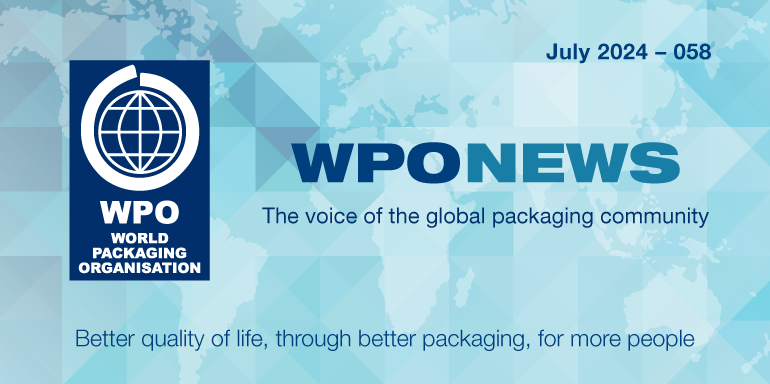














 WPO member, the Packaging Association of Latvia (LIA –
WPO member, the Packaging Association of Latvia (LIA –  Iveta Krauja, former longstanding Chairperson of the the
Packaging Association of Latvia (LIA –
Iveta Krauja, former longstanding Chairperson of the the
Packaging Association of Latvia (LIA – 






 The Assembly of members of Istituto Italiano Imballaggio (
The Assembly of members of Istituto Italiano Imballaggio (












 WPO member in China, World Packaging Center (GPC), is proud
to introduce its new cross-border platform, the World Packaging Cloud (WPC). It
focuses on Southeast Asia and the purpose is to help China's packaging
machinery and printing equipment, packaging containers, and auxiliary material
companies to go overseas and deliver high-quality products to global packaging
users.
WPO member in China, World Packaging Center (GPC), is proud
to introduce its new cross-border platform, the World Packaging Cloud (WPC). It
focuses on Southeast Asia and the purpose is to help China's packaging
machinery and printing equipment, packaging containers, and auxiliary material
companies to go overseas and deliver high-quality products to global packaging
users. 










 The grand prize draw will take place on 25 July 2024, and
the winner will receive the world’s fastest VFFS solution, the tna robag®. The
equipment offers unrivalled speeds of up to 250 bags per minute combined with
wastage as low as 0.1%. It provides superior flexibility and enhanced
serviceability for maximum up-time, and bags just about any type of food
application faster and more efficiently than anyone else.
The grand prize draw will take place on 25 July 2024, and
the winner will receive the world’s fastest VFFS solution, the tna robag®. The
equipment offers unrivalled speeds of up to 250 bags per minute combined with
wastage as low as 0.1%. It provides superior flexibility and enhanced
serviceability for maximum up-time, and bags just about any type of food
application faster and more efficiently than anyone else.



 SIG Alu Free cartons are an aseptic carton
with no aluminium layer. The carton is FSC certified paperboard, is fully
recyclable and produced with 100% renewable energy. The SIG Alu free carton has
a carbon footprint up to 27% lower than standard SIG packaging material, thanks
to a unique composite with no aluminium layer. It is designed for liquid dairy
products such as plain white UHT milk, cream, and other oxygen-insensitive
products. The carton is made from up to 82% renewable paperboard, with
ultra-thin polymer layers to contain and protect products over long periods of
time without the need for refrigeration.
SIG Alu Free cartons are an aseptic carton
with no aluminium layer. The carton is FSC certified paperboard, is fully
recyclable and produced with 100% renewable energy. The SIG Alu free carton has
a carbon footprint up to 27% lower than standard SIG packaging material, thanks
to a unique composite with no aluminium layer. It is designed for liquid dairy
products such as plain white UHT milk, cream, and other oxygen-insensitive
products. The carton is made from up to 82% renewable paperboard, with
ultra-thin polymer layers to contain and protect products over long periods of
time without the need for refrigeration. Seaweeds, characterised by their efficient
utilisation of solar energy and minimal resource requirements, offer a
promising solution to address the pressing challenges of resource scarcity and
environmental degradation.
Seaweeds, characterised by their efficient
utilisation of solar energy and minimal resource requirements, offer a
promising solution to address the pressing challenges of resource scarcity and
environmental degradation. The PaperBoard series has been designed to
eliminate single use plastics, reduce the use of plastics and improve
recyclability of the packs. The material can be run on packaging systems in the
form of rolls, pre-cuts, or trays. Paper fibre and cardboard composites with
different grammages and functional layers are available. The use of functional
layers makes it possible to produce paper-based packs that meet the barrier
property requirements of the respective product.
The PaperBoard series has been designed to
eliminate single use plastics, reduce the use of plastics and improve
recyclability of the packs. The material can be run on packaging systems in the
form of rolls, pre-cuts, or trays. Paper fibre and cardboard composites with
different grammages and functional layers are available. The use of functional
layers makes it possible to produce paper-based packs that meet the barrier
property requirements of the respective product. Another paper-based solution that I saw on
the G.Mondini stand was Paper2Skin which is a unique and innovative paper top
skin web technology designed to take packaging to the next level. The pack has
been designed to eliminate single use plastics, use less material at the start
and ensure that the materials can be separated and recycled easily.
Another paper-based solution that I saw on
the G.Mondini stand was Paper2Skin which is a unique and innovative paper top
skin web technology designed to take packaging to the next level. The pack has
been designed to eliminate single use plastics, use less material at the start
and ensure that the materials can be separated and recycled easily.

 NFC Tags
NFC Tags QR Codes
QR Codes Sensors
Sensors
 With the increasing prevalence of
commercial space flight and the prospect of future travels to Mars, many individuals
are embarking on long-duration space missions. However, the expedition exposes
them to medical issues that arise due to the conditions of the space
environment. Therefore, selecting appropriate packaging in this particular
setting is crucial owing to several aspects like weight limitations,
preservation requirements, ensuring the safety of nutrients in microgravity
conditions, and achieving waste reduction goals. The weight factor is crucial
for minimizing energy consumption [6], while preservation is essential for
maintaining freshness over a more extended period and ensuring the desired
nutritional content. Space organizations and academics must thus find and
strategize for appropriate food packing due to the demanding and isolating
circumstances of the demanding and isolated environment.
With the increasing prevalence of
commercial space flight and the prospect of future travels to Mars, many individuals
are embarking on long-duration space missions. However, the expedition exposes
them to medical issues that arise due to the conditions of the space
environment. Therefore, selecting appropriate packaging in this particular
setting is crucial owing to several aspects like weight limitations,
preservation requirements, ensuring the safety of nutrients in microgravity
conditions, and achieving waste reduction goals. The weight factor is crucial
for minimizing energy consumption [6], while preservation is essential for
maintaining freshness over a more extended period and ensuring the desired
nutritional content. Space organizations and academics must thus find and
strategize for appropriate food packing due to the demanding and isolating
circumstances of the demanding and isolated environment.